Trip Report:
Hummingbirds
and the other wildlife
of
Ecuador
Trip Report
2016
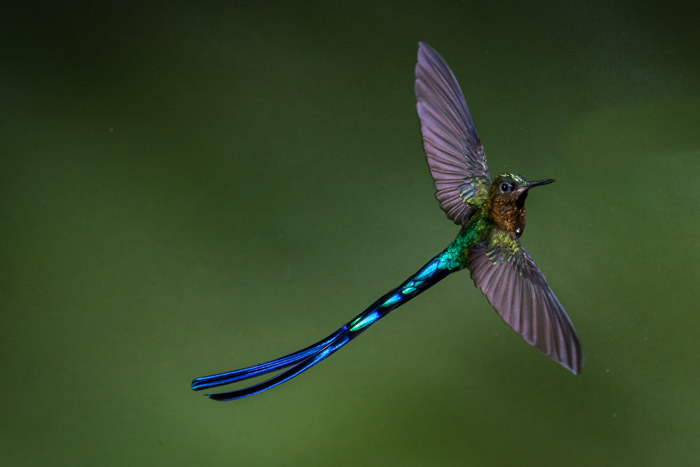
Long-tailed Sylph Hummingbird by Harold Buchanan. One of the most spectacular of the Hummingbirds we photographed, and our group photographed about 35 different species! In total, we saw around 43 species of Hummingbirds, as well as a variety of Tanagers, Toucanets, and more.
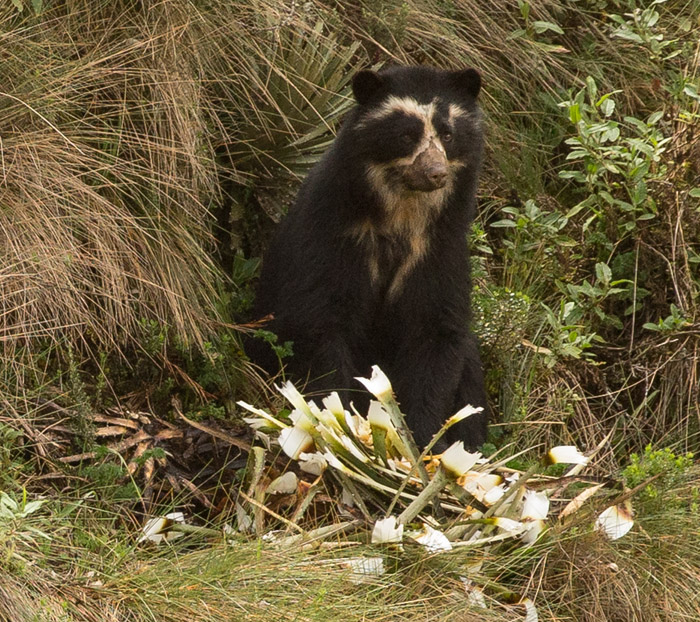 Spectacled Bear. The only bear found in South America and one of the most difficult to photograph, as the bear is uncommon and often found in thick cloud forest. Everyone who did our excursion into the high country got this shot, one of the true highlights of the trip ... and for Mary and my photo highlights for the year!
Spectacled Bear. The only bear found in South America and one of the most difficult to photograph, as the bear is uncommon and often found in thick cloud forest. Everyone who did our excursion into the high country got this shot, one of the true highlights of the trip ... and for Mary and my photo highlights for the year!
Although most of the images in this Trip Report were made by Joe and Mary Ann McDonald, we are especially pleased and humbled by including several of the really great images made by our participants. Those images are credited throughout.
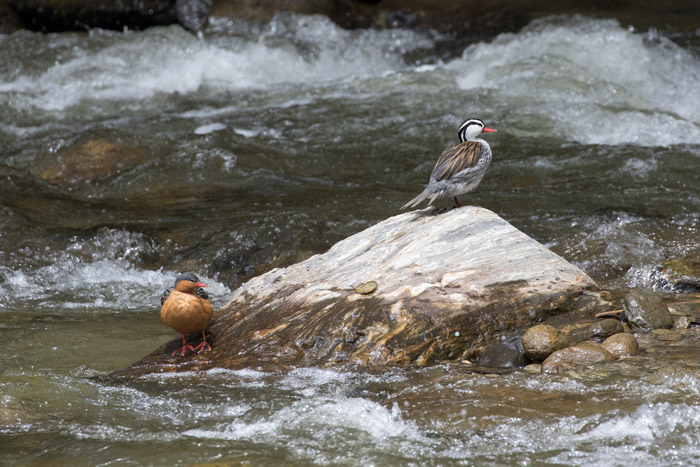 Torrent Ducks by Dick Rhudy. At our second major destination Dick photographed this pair of Torrent Ducks (hen on left, drake on right) resting on a rock in the very turbulent river. To me, this is the nicest shot of these ducks I've seen -- and I've photographed these ducks several times, too!
Torrent Ducks by Dick Rhudy. At our second major destination Dick photographed this pair of Torrent Ducks (hen on left, drake on right) resting on a rock in the very turbulent river. To me, this is the nicest shot of these ducks I've seen -- and I've photographed these ducks several times, too!
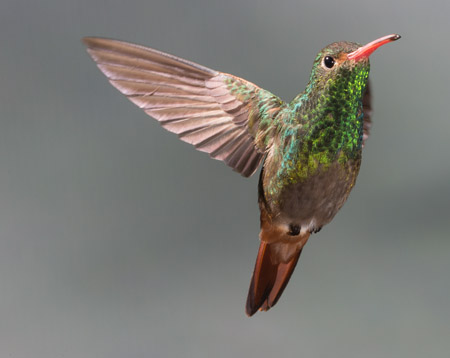
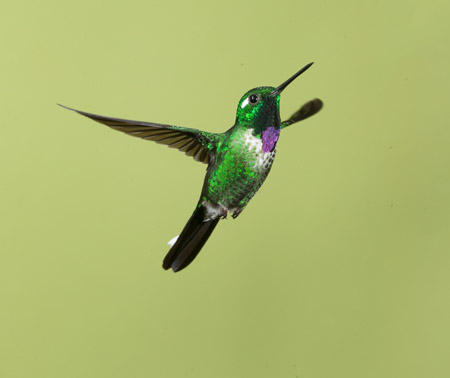
Rufous-tailed Hummingbird, Purple-bibbed Whitetip
This was our second Photo Tour to Ecuador, and the best ever. For whatever reason this year's tour did not completely fill -- bad for us, in a way, but as it turned out, it was the best thing that could have happened. We had brought FIVE high-speed flash set-ups for this tour, which allowed everyone to be on a hummingbird set when we were doing hummers at our first location, and which also allowed Mary or me, or our guide, to use one of the sets as well. For our next trip, we are going to limit the trip to only four participants -- with five flash sets -- something no one else does. When you read (below) what all is involved in this, you'll understand why.
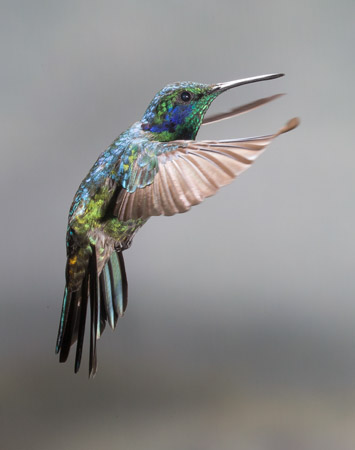 The trip was incredibly successful, with 'the best ever' not being an exaggeration. We had a great shoot with one of the 'trophy' birds of the Andes cloud forest -- the beautiful Cock-of-the-Rock, an unprecedented opportunity with the world's second rarest Bear, the Spectacled Bear, and, with three different major shooting locations (and side trips for other species) we had 43 different Hummingbird species! We also were in Ecuador when this country suffered its worse earthquake in over 70 years, with its epicenter 100 miles from our location, causing us to shake and rattle but otherwise causing no other harm (to us), although the country suffered hugely.
The trip was incredibly successful, with 'the best ever' not being an exaggeration. We had a great shoot with one of the 'trophy' birds of the Andes cloud forest -- the beautiful Cock-of-the-Rock, an unprecedented opportunity with the world's second rarest Bear, the Spectacled Bear, and, with three different major shooting locations (and side trips for other species) we had 43 different Hummingbird species! We also were in Ecuador when this country suffered its worse earthquake in over 70 years, with its epicenter 100 miles from our location, causing us to shake and rattle but otherwise causing no other harm (to us), although the country suffered hugely.
Green Violetear, left
The trip was so productive that we can't wait to do it again, and we'll definitely be doing so in 2018 -- although if there is sufficient interest and if we can fit it in, we might consider returning next year as well. Frankly, I'd love to. At any rate, here's the trip report, and the wonderful images made on this trip.
Interested in joining us in 2018? Please read our Brochure!
Combine this with our 2018 Galapagos Tour - read the report!
Day 1. Our travel to Ecuador was uneventful, the highlight being upgraded to Business Class for the flight from Atlanta to Quito. In Atlanta we met Larry, Harold, and Carol, and just talking about what was to come generated a lot of excitement on our part. We reached Quito late in the evening, and checked in to our hotel by 11PM.
Day 2, Quito to Tandayapa. We met our guide, Lisle, at 6AM, had breakfast, and headed out to Tandayapa and the hummingbirds. We had the option – driving express and right to the lodge, or to go a more scenic route that would get us to the lodge about two hours later. The scenic route goes into high country with wonderful trees festooned with lichens and bromeliads, but the morning was sunny and the light would have been extremely contrasty and as we headed uphill to start the 'scenic' journey I decided to change plans and we headed directlyto the lodge.
That ended up being a great change, as we nowhad the entire morning to break down all of the gear, to assemble the five backgrounds, to get batteries into 20 flashes and 25 transmitters, to set up light stands and backgrounds stands and articulating arms and clamps, and to charge up newly purchased AAs, etc. By lunch we were almost ready to begin the shoot, and by 2:30PM everyone was on the sets shooting away. Lisle, our guide, was impressed, as he said all of the groups he'd guided here took an entire day to get organized, and we were shooting within four 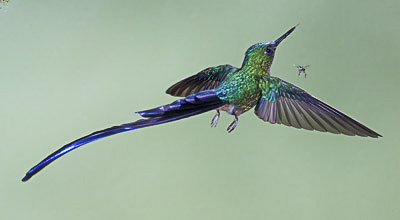 hours of our arrival! It was an extremely successful day for everyone, with the highlight probably being the Violet-tailed Sylph Hummingbird (left and below)that, at the very least, Mary, Harold, and Larry caught in flight, tail spread and the beak outside of the feeder. I was fairly busy running around the sets checking on things, and Mary experimented with finding a suitable location for our Set 5, finally arriving at the location we’d use later on.
hours of our arrival! It was an extremely successful day for everyone, with the highlight probably being the Violet-tailed Sylph Hummingbird (left and below)that, at the very least, Mary, Harold, and Larry caught in flight, tail spread and the beak outside of the feeder. I was fairly busy running around the sets checking on things, and Mary experimented with finding a suitable location for our Set 5, finally arriving at the location we’d use later on.
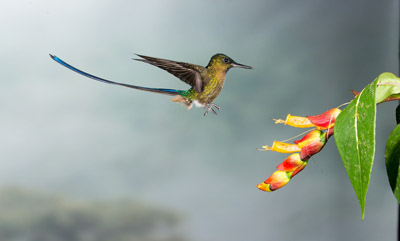
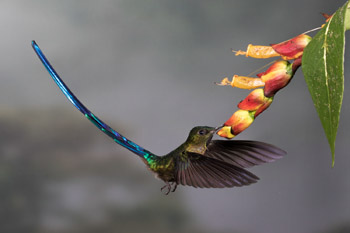
Violet-tailed Sylph by Dick Rhudy
Day 3. We left at 6:30 for a small private reserve, Suamox, where we’ve had sloths in the past, and macro subjects, and a variety of hummingbirds and tanagers and woodpeckers at their feeders. We'd just left the lodge when we found two Green-crowned Brilliant Hummingbirds locked in a death-match, apparently fighting over territory. Photo, below, by Harold Buchanan.
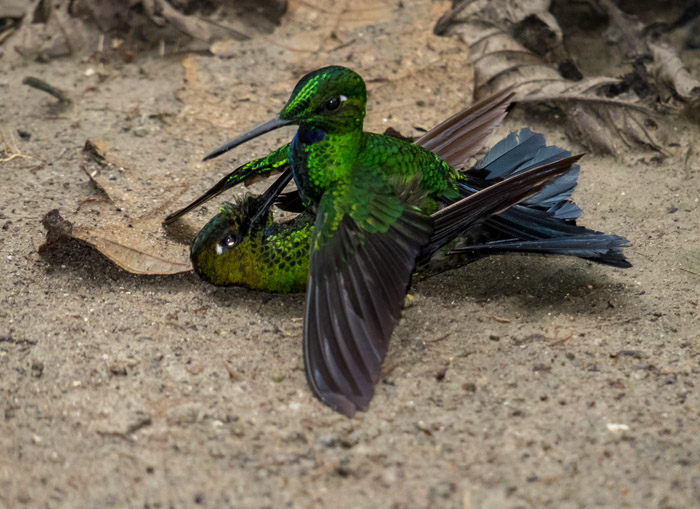 They struggled and stabbed at each other on the dirt road, ignoring all of us as we took photos. Luckily, the birds eventually carried their fight to the edge of the road and went over the side, into bushes, where they were safe from passing vehicles. Today the shooting at Suamox was fairly slow, with no Hermit Hummingbirds, and rather minimal activity at the feeders. We did have several woodpecker species and tanagers, but over-all, it was disappointing. I went looking for other subjects for us, and walked about 2km of what I was to learn was 15km of trails. I saw nothing of interest, although the forest was beautiful --- it was just slow today.
They struggled and stabbed at each other on the dirt road, ignoring all of us as we took photos. Luckily, the birds eventually carried their fight to the edge of the road and went over the side, into bushes, where they were safe from passing vehicles. Today the shooting at Suamox was fairly slow, with no Hermit Hummingbirds, and rather minimal activity at the feeders. We did have several woodpecker species and tanagers, but over-all, it was disappointing. I went looking for other subjects for us, and walked about 2km of what I was to learn was 15km of trails. I saw nothing of interest, although the forest was beautiful --- it was just slow today.
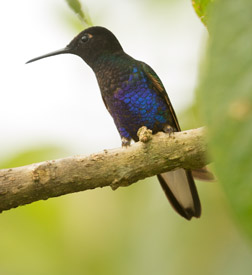
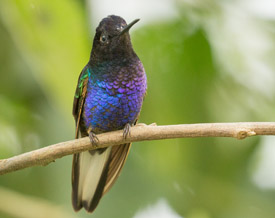
Velvet-purple Coronet
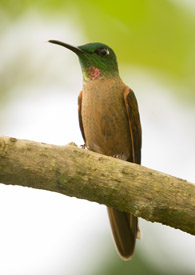
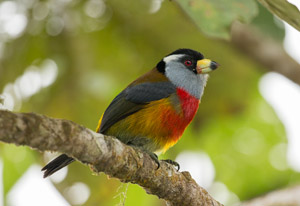
Fawn-breasted Brilliant, Toucan Barbet
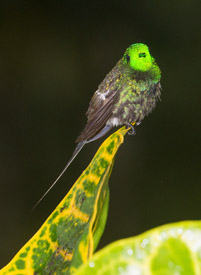
Green Thorntail
 We left Suamox early to head to lunch at a restaurant that overlooks a broad, deep canyon, and has bird and hummingbird feeders right outside the restaurant. We ended up staying here until 5PM, the shooting was wonderful. Crimson-rumped Toucanet (photo, left, by Dick Rhudy), Collared (Pale-mandibled) Aracari, and a wide variety of Tanagers – Lemon Rumped, Rufous Throated, Flame-faced, Blue-gray, Palm, Golden, Silver-throated, and Woodpecker – Golden Olive and Black-cheeked, and Hummingbirds – Green Thorntail, White-necked Jacobin, Andean Emerald, Green-crowned Brilliant, Rufous-tailed; and Bananaquits, Orange-bellied, Orange-crowned, and Thick-billed Euphonias – a very productive day. Blue-chested and Black-throated Mangos were two other hummers seen today.
We left Suamox early to head to lunch at a restaurant that overlooks a broad, deep canyon, and has bird and hummingbird feeders right outside the restaurant. We ended up staying here until 5PM, the shooting was wonderful. Crimson-rumped Toucanet (photo, left, by Dick Rhudy), Collared (Pale-mandibled) Aracari, and a wide variety of Tanagers – Lemon Rumped, Rufous Throated, Flame-faced, Blue-gray, Palm, Golden, Silver-throated, and Woodpecker – Golden Olive and Black-cheeked, and Hummingbirds – Green Thorntail, White-necked Jacobin, Andean Emerald, Green-crowned Brilliant, Rufous-tailed; and Bananaquits, Orange-bellied, Orange-crowned, and Thick-billed Euphonias – a very productive day. Blue-chested and Black-throated Mangos were two other hummers seen today.
At the restaurant we were shooting under cover, while it rained through most of the afternoon. Here at the lodge it rained most of the day, so it would have been difficult or impossible to photograph here – our itinerary was a lucky break.
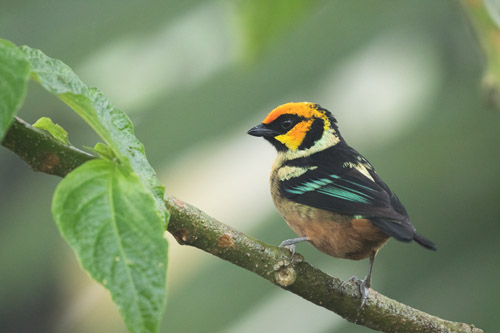
Flame-faced Tanager by Dick Rhudy
As dinner ended, and I was getting the flashes and equipment ready for tomorrow, I noticed the large picture window of our lodge vibrating, vibrating hard. At first I thought we were having heavy winds, but the trees were still. Earthquake! Everyone got the idea almost immediately and Lyle rushed everyone out the nearest door, while I jumped out the other exit, where a couple of limbs smashed into the patio. Everyone else went to a relatively clear assembly point, and after a few minutes they noticed I was missing, and began yelling my name. By then all the lights had gone out, we had one cell phone flashlight, and through the dim light I ran through the lobby and rejoined the group. Once we had power restored folks checked the internet and found that the earthquake located about 100 miles to our west, along the coast, and registered 7.4. It made for an exciting conclusion of the day.
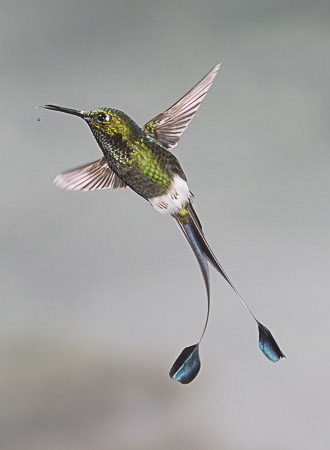
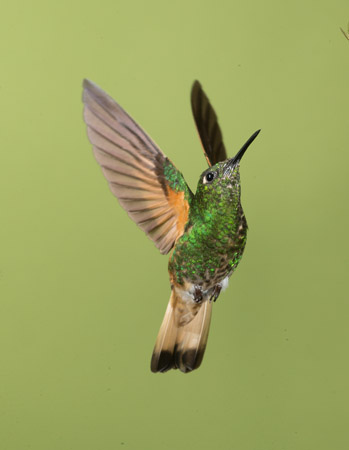
Booted Racquet-tailed;
Buff-tailed Coronet
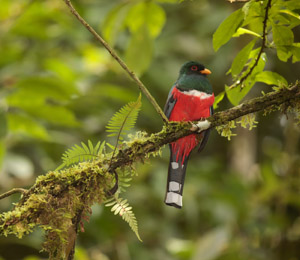
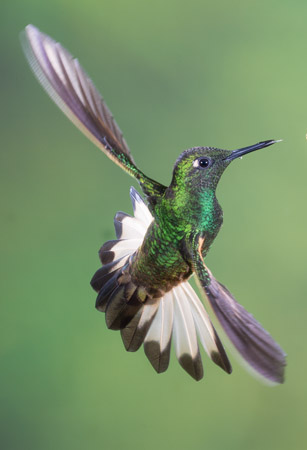
Masked Trogon,
Velvet-purple Coronet
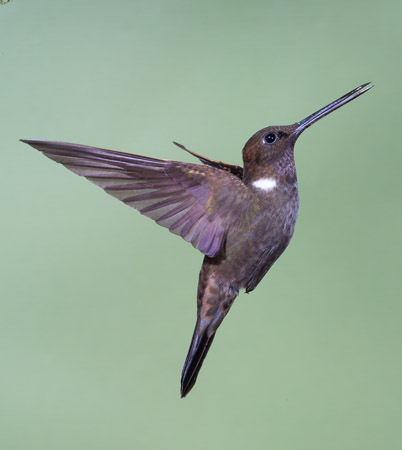
Brown Inca
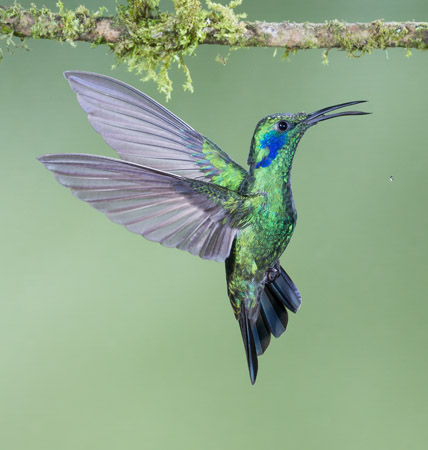
Green Violetear
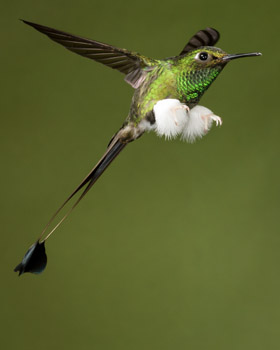
Booted Racquet-tail
Day 4. Tandayapa
The earthquake proved devastating for the epicenter area. At this point nearly 300 people have died, and 1,600 are injured. Roads towards the coast were closed, and for a while, because of landslides, Quito was isolated. In between hummingbird sets we saw nippets of news, and the horrendous footage.
We spent the morning shooting, planning on a side excursion to Milpe, another hummer location, after lunch, but it began to rain, and with increased emergency aid traffic on the roads we decided to stay at the lodge. The rain helped – it poured through much of the afternoon. When it finally broke I had a chance to do some experimenting with flower setups, and followed that with a PS session on adding a flower, and doing masking, in PS.
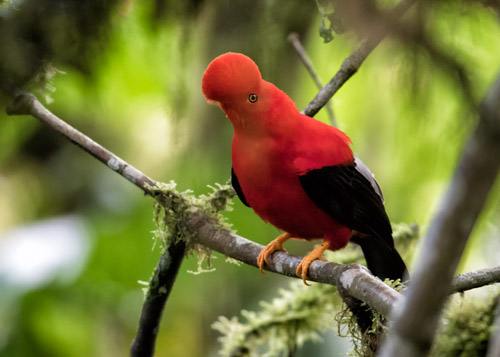
Day 5. Tandayapa
We left at 4:45AM for a 40 minute drive to reach a blind/observation area for the spectacular Cock-of-the-Rock (above). We almost arrived late, as our guide thought the blind was at one place, and the driver another, and so we drove further up a dirt road before U-turning it and heading back. Then, our guide needed to run down an unmarked trail to check, and luckily, that was the blind! Birders were already at the roadside, but fortunately none of the birders had cameras and so we had our pick of the observation area. I entered the blind last, and squeezed in along the far left side where I waited, while two males called their screechy note (analogous, to me, 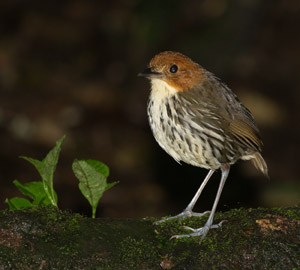 to fingernails going across a blackboard). Most of us had no shots, but very attractive perches were in front of us, if only the birds would perch there.
to fingernails going across a blackboard). Most of us had no shots, but very attractive perches were in front of us, if only the birds would perch there.
Eventually one did, the closest and clearest view I ever had of this unusual bird. The large orange crest begins at the base of the beak and extends forward, giving the bird an almost beakless look. The color, a flame orange-red, is vivid, and for everyone, having a good, close view was the highlight of the day.
Afterwards, we headed to a stream where we had a brief view of a (left) Yellow-breasted Antpitta, which a local guide called out by a wonderful mimicry of the bird’s call.
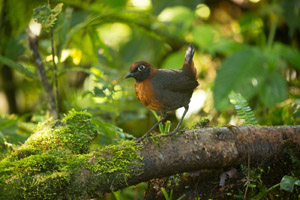 Afterwards, we hiked a few hundred yards, mostly up hill, to see a Rufous-breasted Ant-Thrush (left). It didn’t stay long, but we did manage some photos. Next, we drove on to another location where we hiked downhill for a … Antpitta, a small, almost sparrow-like bird. There was a lot of effort involved in getting these rather nondescript forest birds, but seeing these, or photographing them, is quite difficult and for anyone interested in birds … worth the effort.
Afterwards, we hiked a few hundred yards, mostly up hill, to see a Rufous-breasted Ant-Thrush (left). It didn’t stay long, but we did manage some photos. Next, we drove on to another location where we hiked downhill for a … Antpitta, a small, almost sparrow-like bird. There was a lot of effort involved in getting these rather nondescript forest birds, but seeing these, or photographing them, is quite difficult and for anyone interested in birds … worth the effort.
The facility offered breakfast next, traditional and excellent, and we spent the rest of the morning doing natural light shooting of a variety of hummingbirds, Toucan Barbets, and Mountain Tanagers. The morning was excellent.
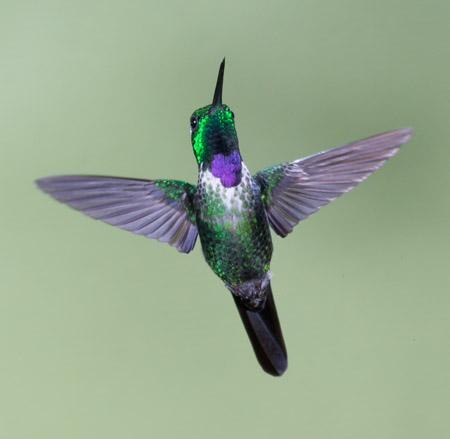
Purple-bibbed Whitetip
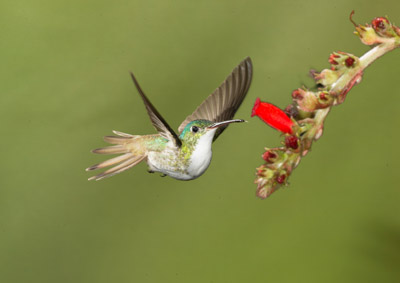
Andean Emerald
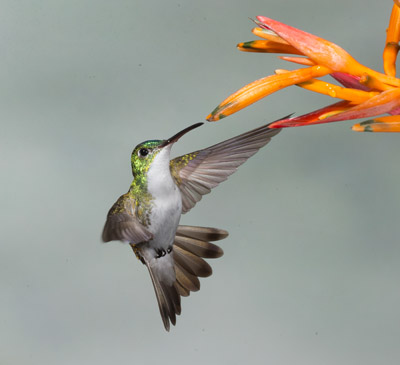
Andean Emerald
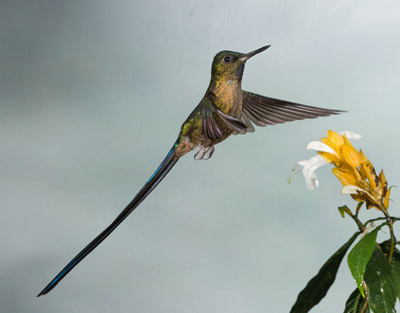
Violet-tailed Sylp
After lunch we photographed more hummers at our high-speed sets, and luckily the weather held, with no rain through the day. Our last hour we had great luck with baiting a flower with sugar water, and the conclusion of this shoot involved shooting a variety of species at the flower, including, once again, the spectacular Violet-tailed Sylph.
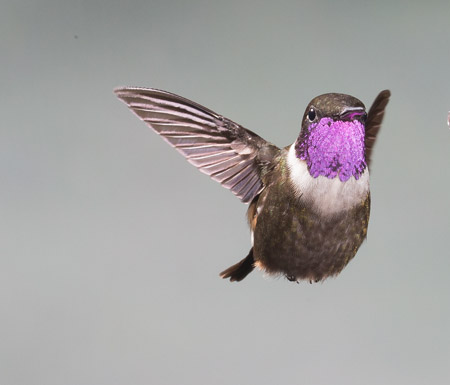
Purple-throated Woodstar
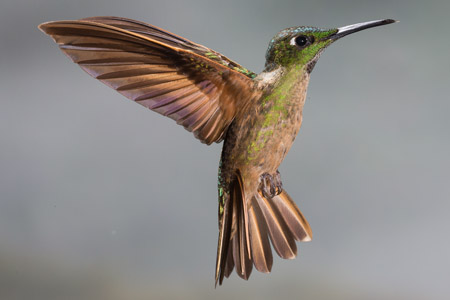
Fawn-breasted Brilliant
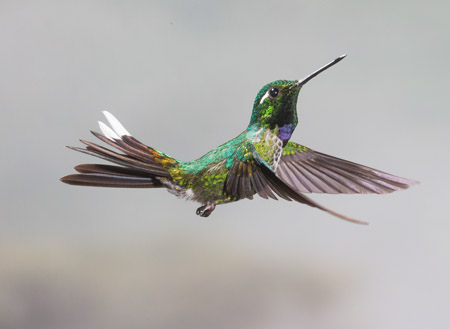
Purple-bibbed Whitetip
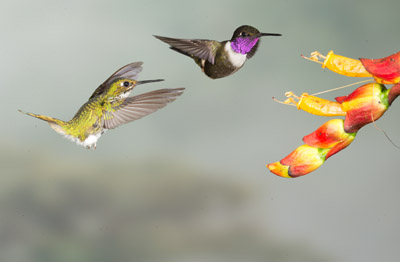
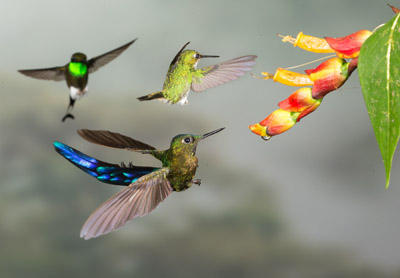

Day 6. To Guango
We left at 7:45, passing through Quito and continuing on over the Andes, crossing through a tundra-like, treeless landscape of clumpy grasses. We looked for Spectacled Bears, unsuccessfully, but Mary did spot a rare-to-see-here Andean Condor, that soon sailed into the low clouds and disappeared. We reached Guango before lunch, and began scouting out locations for more flash setups.
Bird activity was scattered, and we had more success with on-camera flash, balanced with ambient light, and didn’t bother with doing a setup this afternoon. The shooting, however, was constant, and we added another 8 species of Hummingbirds for the day.
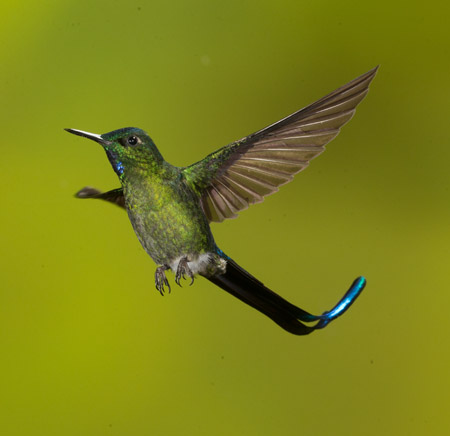
Long-tailed Sylph
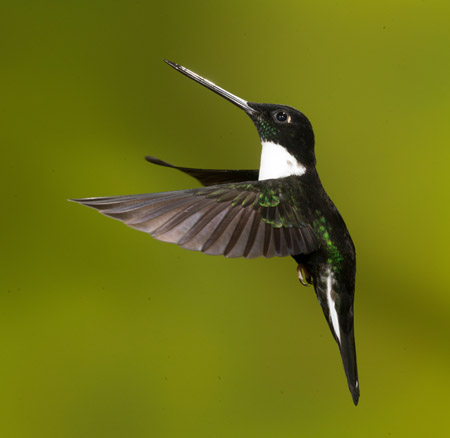
Collared Inca
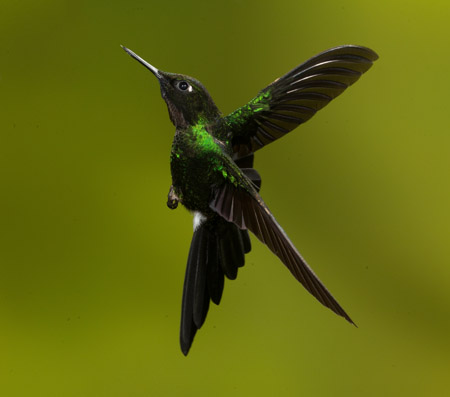
Tourmaline Sunangel (above and below)
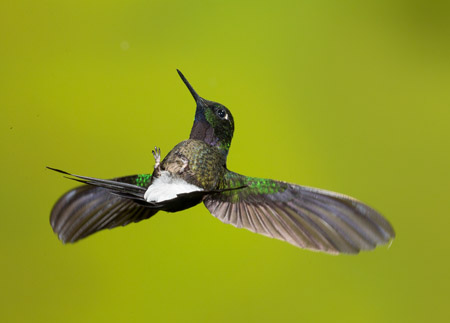
Because of nightly rain, and an earthquake, of course!, I didn't have a chance to do serious bat photography, but I tried, and managed a few shots with the new Sabre by Cognisys. Unfortunately the activity was so infrequent that, unlike our Costa Rica shoot where we do a night or two of very productive bat shooting, it wasn't worth trying to set up the group.
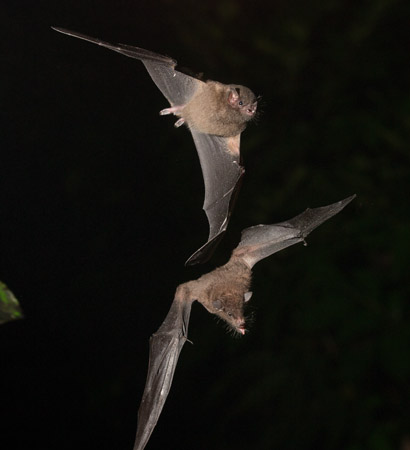
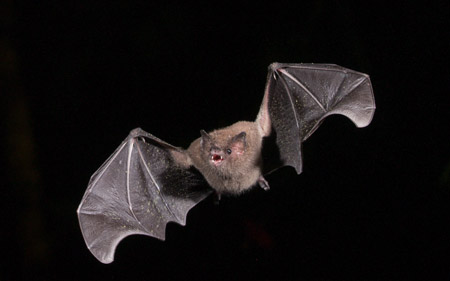
Day 7. Guango - Papallacta Pass – Antisana-Papallacta National Park
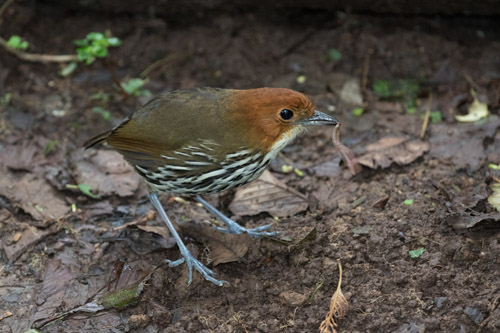
Chestnut-crowned Antpitta by Dick Rhudy
We had a very early cooked breakfast and then headed west, returning to the high Andes pass where we hoped to photograph the volcanos at sunrise and, hopefully, a Spectacled Bear. The mountains were shrouded in clouds, and visibility was down to only a few hundred yards. Not having any scenic possibilities, we drove back to the main highway and onto a dirt road where our guide’s friends have often seen bears.
The road would, in theory, intersect with the main highway closer to our lodge, but fortunately a landslide had closed the road and we had to return to the top. We decided to drive up the ‘scenic’ road once again, and luckily we encountered another guide who reported he had just seen a bear below us. We looked, but had no luck, so we took another road that we felt was in the direction the bear was headed. I was worried that the bear may have crossed the road and been below us, so I got out of the vehicle and walked along the road, looking down into the meadows below. I saw what I thought might be a track, but I wasn’t sure and, regardless, continued down the road. I hadn’t gone far when I spotted a Spectacled Bear standing on the edge of a ledge, in full view, facing me. It was a spectacular view, and my only TWO regrets were, one, I wasn’t carrying my camera!, and two, I didn’t savor the view and soak it all in. Instead, after seeing what I had, I turned, and ran back to the bus to alert everyone and to get our gear.
The bear was still there, but now somewhat behind a ledge, and to my horror I realized I hadn’t changed any of my camera settings from last night’s experiment with flash and hummers at slow shutter speeds. The bear turned, and I shot a few frames – at 1 second! The bear disappeared over a rise and I ran up the road, looking for a spot where I could climb up onto the ridge to find the bear.
About 70 yards up the road I found a route, but it turned out to be absolutely, completely, totally difficult. I was wheezing from the climb, which involved grabbing grasses and brush, pulling myself up what was as close to near vertical as a vegetated slope could be. Twice I stopped to catch my breath and question – could I do this. I did, and found at the top --- nothing. Getting down was even more challenging, as the initial route, which had the first number of feet easy, I missed, and had to traverse the slope, gradually moving down and hoping that the vegetation didn’t give and get me tumbling.
Back at the bus, we drove down the road, hoping to head the bear off, and then returned to our first route, thinking the bear may have climbed higher and returned to the marsh where it had first been seen. We didn’t see the bear, and returned once more to the road where we’d seen the bear, and after driving its length, and doing a U-turn, we found the bear again, only about 50 yards from where I’d first seen it.
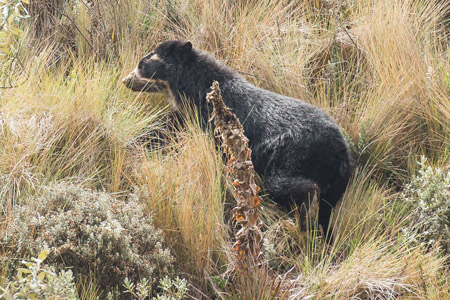 The bear was eating the roots of an agave, and seemed preoccupied and not too shy. We drove a little closer and did shots, and then I told our guide and our driver to drive closer, as there was a turnout directly below the bear where all of us could shoot from the left side of the bus through the open windows. Somehow, my direction, ‘drive and turn right’ was misconstrued so that the driver drove straight, and then turned a bit left, making our shooting angle even more difficult. At this point I lost my temper and barked to our guide and driver, ‘Turn the #$%$# bus to the right!’ Unfortunately, because of the confusion and procrastination in making the correct turn we lost our shooting window for closer images of the bear feeding on the flower stalks and the bear, completing its meal, walked off. Luckily, the bear didn't disappear immediately but instead continued on the hillside towards us, where it paused, to give us a fairly decent view before finally disappearing.
The bear was eating the roots of an agave, and seemed preoccupied and not too shy. We drove a little closer and did shots, and then I told our guide and our driver to drive closer, as there was a turnout directly below the bear where all of us could shoot from the left side of the bus through the open windows. Somehow, my direction, ‘drive and turn right’ was misconstrued so that the driver drove straight, and then turned a bit left, making our shooting angle even more difficult. At this point I lost my temper and barked to our guide and driver, ‘Turn the #$%$# bus to the right!’ Unfortunately, because of the confusion and procrastination in making the correct turn we lost our shooting window for closer images of the bear feeding on the flower stalks and the bear, completing its meal, walked off. Luckily, the bear didn't disappear immediately but instead continued on the hillside towards us, where it paused, to give us a fairly decent view before finally disappearing.
Our bear search and photography took us all morning, and we returned to the lodge at nearly noon. The bear was a highlight for the trip, as Spectacled Bears are the most difficult of all bears to see, excepting the jungle-inhabiting Sun Bear (which virtually no one sees). One can hope to see a Spectacled Bear, as it is possible, but the likelihood is slim. We were elated, and quite happy with our success.
After lunch we shot more hummingbirds, and Harold and Mary and Dick all had fairly good luck with the elusive Swordbill Hummingbird (below). I managed only three shots, and each time the bird’s wings covered its head! Mary did much better.
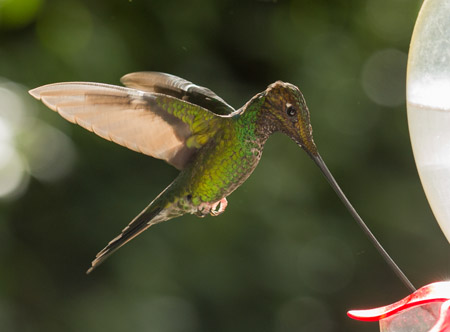
We set up one high speed flash setup and it proved successful, with Long-tailed Sylphs, Collared Inca, Sun Angel, and Chestnut-breasted Coronets all coming in fairly regularly. It didn’t rain all day, and Turquoise Jays, Wood Creepers, and Torrent Duck all being highlights.
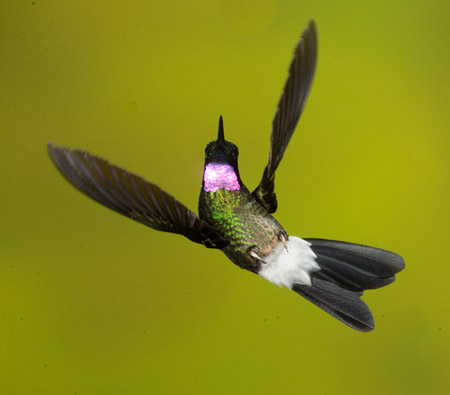
Tourmaline Sunangel
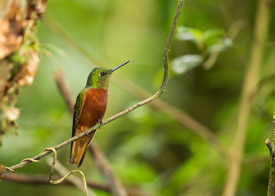
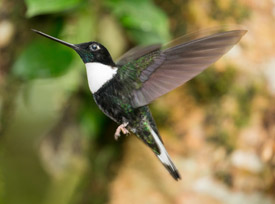
Chestnut-breasted Coronet, Collared Inca
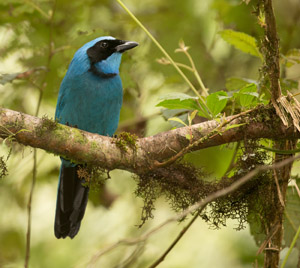
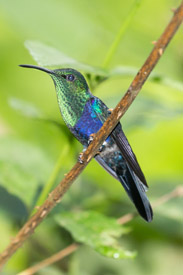
Turquoise Jay, Fork-tailed Woodnymph
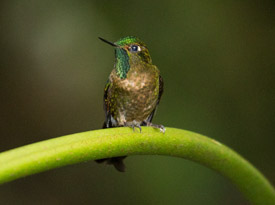
Tyrian Metaltail
Day 8. Guango to Wild Sumaco
It rained during the night and continued into the morning, making our departure from Guango a bit easier – it would have been unpleasant shooting. We had about a three and a half hour drive, descending into the Amazon highlands, where the volcano Sumaco dominated the horizon, and our lodge is located in, or near, the national park. Along the way we must have passed a dozen land slides, some that had to have choked off the road when the rocks and mud crashed downward.
Like everywhere else, the landscape is a series of serrated ridges, incredibly rough country disguised by the cloak of vegetation. Sumaco is jungle, although everywhere we’ve been basically is, but the landscape is definitely tropical, with banana trees, palms, and giant trees festooned with bromeliads, lichens, and ferns.
The lodge has a large porch or veranda where, on either end, hummingbird feeders were placed in trees, and all heavily visited by hummers. We spent a portion of the afternoon photographing around the lodge, while I tried to setup something for high speed flash but the birds, accustomed to their usual feeders (and we were not allowed to remove their’s), ignored our feeders. Worse, by late afternoon honeybees had swarmed around the tubes, making the shooting impossible.
We did check out two other locations that required our driving to the location, where more hummingbird feeders were placed. At one, flash wasn’t allowed, and since that station was deep in the forest and dark, we simply abandoned that idea.
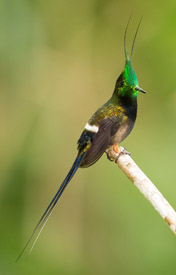
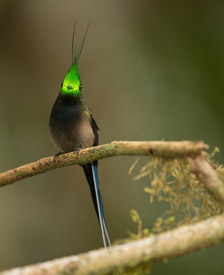
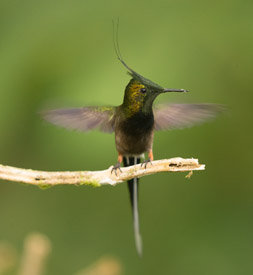
Wire-crested Thorntail
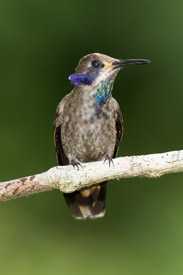
Brown Violetear
The other was good, but faced the west, and so we were a bit uncomfortable facing into the sunlight. Accordingly, after about an hour of ‘scouting’ we decided to continue shooting at the lodge, and planned on visiting this station the following morning, when the sun would be to our backs.
The remainder of the afternoon was spent photographing the hummers around the lodge, but by 5:30 the activity died, and all of us relaxed and watched a sunset over the ridges, a welcome change of pace for all of us.
Day 9. Wild Sumaco
 Tamarin-16-5072.jpg)
 Tamarin-16-4986.jpg)
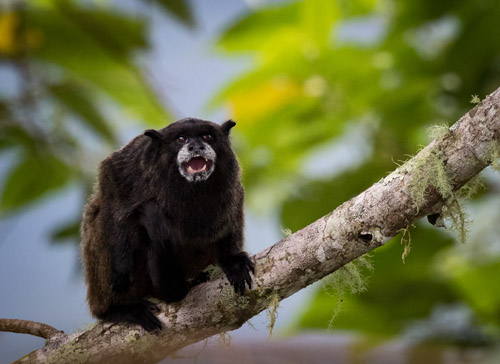
Photo above, Napo Tamarin by Harold Buchanan
The feeders were empty, which was a bit of a disappointment for me as the lodge should be keeping current with that status. I filled the feeders, and we photographed hummers while waiting for Napo Tamarin, squirrel-sized primates, to come in to a feeding station where bananas had been hoisted, via a cable. Again, I was a bit frustrated that the bananas were on a tree some distance away, and a few trees that were closer could have been used instead. Whatever.
The Tamarins arrived, and by cropping in we did manage nice shots. These primates are quite vocal, emitting a high pitched whistle constantly, while the Tamarins grabbed sections of banana and ran off to separate feeding areas. At one point another troop arrived, announcing themselves by whistles, and the resident (or first) troop raced off, seemingly in panic. The Tamarins rocketed into the air, dropping twenty or more feet to land on other trees, reminding me of lemurs or langur monkeys. At any rate, they wanted to get away!
We had some windows for shooting, between gaps in leaves or trees, and the Tamarins stayed around the lodge area for about 45 minutes. We hoped to do more tomorrow.
Afterwards we headed to the feeding station in the forest, where we spent the remainder of the morning. We used on-camera flash, either on TTL or on Manual Mode, where the flash duration was dropped to 1/16th or lower. Despite using only one flash we were fairly successful, and everyone managed some nice shots of the 12 new species we had here at Samaco.
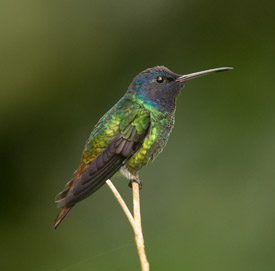
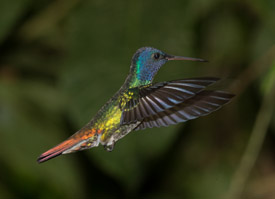
Golden-tailed Saphire
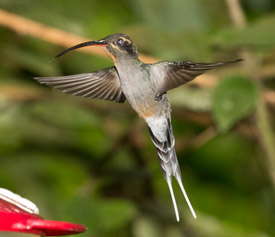
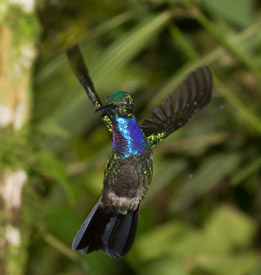
Tawny-bellied Hermit, Black-throated Brilliant
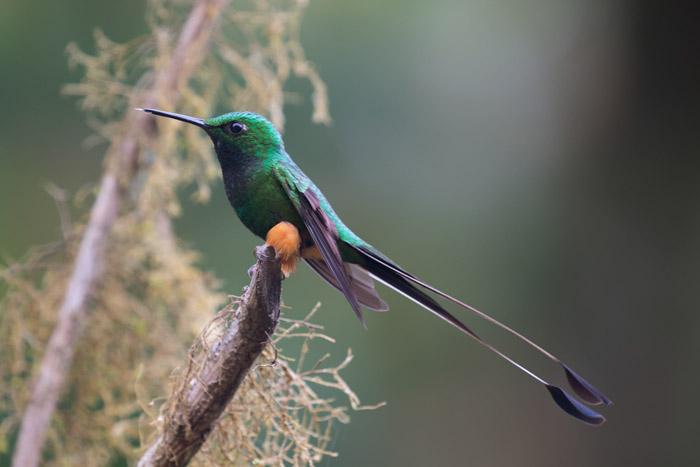 Booted Racettail (eastern variety) by Dick Rhudy
Booted Racettail (eastern variety) by Dick Rhudy
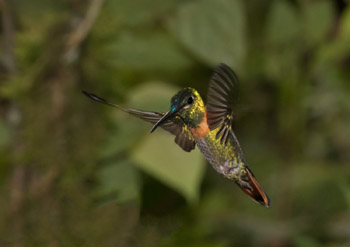
Gould's Jewelfront by Dick Rhudy
Rain threatened, and we quit and returned to the bus just minutes before a deluge that continued through the early afternoon. At 3PM Larry, Carol, our guide, and I 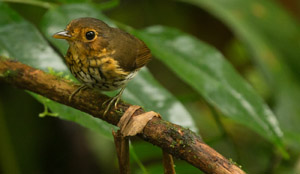 headed back into the forest to photograph another Antpitta, the Ochre-breasted Antpitta. The trail was all downhill, about a quarter mile, terminating at a tiny clearing where the local guide tossed worms. A White-collared Quail-Dove came in first, and we were worried that it might drive off the Antpitta. It didn’t, and we managed some nice shots of this small, somewhat thrush-like bird.
headed back into the forest to photograph another Antpitta, the Ochre-breasted Antpitta. The trail was all downhill, about a quarter mile, terminating at a tiny clearing where the local guide tossed worms. A White-collared Quail-Dove came in first, and we were worried that it might drive off the Antpitta. It didn’t, and we managed some nice shots of this small, somewhat thrush-like bird.
The remainder of the afternoon as spent, for us, in packing all the gear required for this trip, and processing images (everyone) for a final slide show. We did the show after dinner, and many of the images in this trip report from our participants. The portfolio was stellar, and a great testament to the wonderful opportunities we had on this trip.
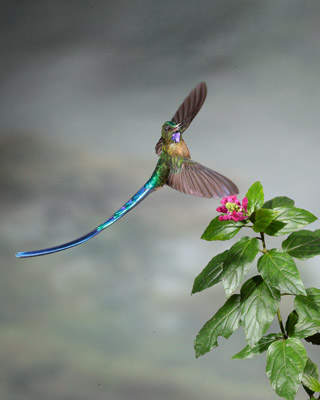 Regarding gear, here’s what we brought along for the high speed hummingbird sets.
Regarding gear, here’s what we brought along for the high speed hummingbird sets.
5 Flash set-ups, using 4 flashes at each set.
10 Manfrotto Articulating Arms and Super Clamps, and Clamps, for backgrounds and feeders.
8 different Backgrounds
23 Lightstands (12 were supplied by our outfitter)
12 Remote flash triggering systems (5 supplied by the outfitter, and not needed). Each triggering system included 4 flash receivers and 1 transmitter.
8 special Hummingbird feeders.
2 Range IRs and assorted cables for connecting cameras or flashes
All of this was packed in six duffle bags that we checked-in for our flight from the US to Ecuador.
2 Sabre camera triggering systems
Day 7. Wild Sumaco to Quito
Our last day, and we spent the morning around the porch of the lodge. I tried, nearly all morning, to photograph a Violet-headed Hummingbird that never visited feeders but fed regularly upon small pinkish flowers of the shrubs around our rooms. Although I got a few shots, including a stunning rear-end view when the bird veered away, most of the time the bird almost studiously avoided the flower where I had my camera aimed. Quite frustrating. Mary worked the same bird and had some real success.
On our hike to the Antpitta yesterday I was struck by the beauty of the forest, and the fact that I had not shot many scenics. I took the time this morning to do some, and vowed to do far more on our next visit. Storms were threatening, so we packed the bus early, and lucky we did, as it began to rain at the time we had planned to load, but the rain had nearly stopped by the time lunch was over and we boarded the bus for the trip to Quito.
Although Mary slept a part of the way, when she was awake she counted 71 landslides that touched the road. We figured that we must have had 100 in total, although none were serious. The road had a few spots where the slope below slipped and tore the edge of the road away with it, and we had to wonder how the road engineers decided how much they cut into the bank, therefore creating a steeper overhang, when they made this road.
The trip to Quito went uneventfully, with the mountain pass completely hidden in low clouds and fog. We dropped Dick, Harold, and Carol off at the airport, while Larry, Mary, and I continued on to the hotel where we met our group for the Galapagos. At the hotel we had our last Hummingbird species, the Sparkling Violetear, our 43rd for the trip.
On Mary, Larry, and my post-trip to Peru and Macchu Picchu, we also had another hummer, one we'd hoped to see for a long time -- the Giant Hummingbird. True to its name, it as as big as a sparrow.
Trip Report:
Hummingbirds
and the other wildlife
of
Ecuador
Trip Report
2016

Long-tailed Sylph Hummingbird by Harold Buchanan. One of the most spectacular of the Hummingbirds we photographed, and our group photographed about 35 different species! In total, we saw around 43 species of Hummingbirds, as well as a variety of Tanagers, Toucanets, and more.
 Spectacled Bear. The only bear found in South America and one of the most difficult to photograph, as the bear is uncommon and often found in thick cloud forest. Everyone who did our excursion into the high country got this shot, one of the true highlights of the trip ... and for Mary and my photo highlights for the year!
Spectacled Bear. The only bear found in South America and one of the most difficult to photograph, as the bear is uncommon and often found in thick cloud forest. Everyone who did our excursion into the high country got this shot, one of the true highlights of the trip ... and for Mary and my photo highlights for the year!
Although most of the images in this Trip Report were made by Joe and Mary Ann McDonald, we are especially pleased and humbled by including several of the really great images made by our participants. Those images are credited throughout.
 Torrent Ducks by Dick Rhudy. At our second major destination Dick photographed this pair of Torrent Ducks (hen on left, drake on right) resting on a rock in the very turbulent river. To me, this is the nicest shot of these ducks I've seen -- and I've photographed these ducks several times, too!
Torrent Ducks by Dick Rhudy. At our second major destination Dick photographed this pair of Torrent Ducks (hen on left, drake on right) resting on a rock in the very turbulent river. To me, this is the nicest shot of these ducks I've seen -- and I've photographed these ducks several times, too!


Rufous-tailed Hummingbird, Purple-bibbed Whitetip
This was our second Photo Tour to Ecuador, and the best ever. For whatever reason this year's tour did not completely fill -- bad for us, in a way, but as it turned out, it was the best thing that could have happened. We had brought FIVE high-speed flash set-ups for this tour, which allowed everyone to be on a hummingbird set when we were doing hummers at our first location, and which also allowed Mary or me, or our guide, to use one of the sets as well. For our next trip, we are going to limit the trip to only four participants -- with five flash sets -- something no one else does. When you read (below) what all is involved in this, you'll understand why.
 The trip was incredibly successful, with 'the best ever' not being an exaggeration. We had a great shoot with one of the 'trophy' birds of the Andes cloud forest -- the beautiful Cock-of-the-Rock, an unprecedented opportunity with the world's second rarest Bear, the Spectacled Bear, and, with three different major shooting locations (and side trips for other species) we had 43 different Hummingbird species! We also were in Ecuador when this country suffered its worse earthquake in over 70 years, with its epicenter 100 miles from our location, causing us to shake and rattle but otherwise causing no other harm (to us), although the country suffered hugely.
The trip was incredibly successful, with 'the best ever' not being an exaggeration. We had a great shoot with one of the 'trophy' birds of the Andes cloud forest -- the beautiful Cock-of-the-Rock, an unprecedented opportunity with the world's second rarest Bear, the Spectacled Bear, and, with three different major shooting locations (and side trips for other species) we had 43 different Hummingbird species! We also were in Ecuador when this country suffered its worse earthquake in over 70 years, with its epicenter 100 miles from our location, causing us to shake and rattle but otherwise causing no other harm (to us), although the country suffered hugely.
Green Violetear, left
The trip was so productive that we can't wait to do it again, and we'll definitely be doing so in 2018 -- although if there is sufficient interest and if we can fit it in, we might consider returning next year as well. Frankly, I'd love to. At any rate, here's the trip report, and the wonderful images made on this trip.
Interested in joining us in 2018? Please read our Brochure!
Combine this with our 2018 Galapagos Tour - read the report!
Day 1. Our travel to Ecuador was uneventful, the highlight being upgraded to Business Class for the flight from Atlanta to Quito. In Atlanta we met Larry, Harold, and Carol, and just talking about what was to come generated a lot of excitement on our part. We reached Quito late in the evening, and checked in to our hotel by 11PM.
Day 2, Quito to Tandayapa. We met our guide, Lisle, at 6AM, had breakfast, and headed out to Tandayapa and the hummingbirds. We had the option – driving express and right to the lodge, or to go a more scenic route that would get us to the lodge about two hours later. The scenic route goes into high country with wonderful trees festooned with lichens and bromeliads, but the morning was sunny and the light would have been extremely contrasty and as we headed uphill to start the 'scenic' journey I decided to change plans and we headed directlyto the lodge.
That ended up being a great change, as we nowhad the entire morning to break down all of the gear, to assemble the five backgrounds, to get batteries into 20 flashes and 25 transmitters, to set up light stands and backgrounds stands and articulating arms and clamps, and to charge up newly purchased AAs, etc. By lunch we were almost ready to begin the shoot, and by 2:30PM everyone was on the sets shooting away. Lisle, our guide, was impressed, as he said all of the groups he'd guided here took an entire day to get organized, and we were shooting within four  hours of our arrival! It was an extremely successful day for everyone, with the highlight probably being the Violet-tailed Sylph Hummingbird (left and below)that, at the very least, Mary, Harold, and Larry caught in flight, tail spread and the beak outside of the feeder. I was fairly busy running around the sets checking on things, and Mary experimented with finding a suitable location for our Set 5, finally arriving at the location we’d use later on.
hours of our arrival! It was an extremely successful day for everyone, with the highlight probably being the Violet-tailed Sylph Hummingbird (left and below)that, at the very least, Mary, Harold, and Larry caught in flight, tail spread and the beak outside of the feeder. I was fairly busy running around the sets checking on things, and Mary experimented with finding a suitable location for our Set 5, finally arriving at the location we’d use later on.


Violet-tailed Sylph by Dick Rhudy
Day 3. We left at 6:30 for a small private reserve, Suamox, where we’ve had sloths in the past, and macro subjects, and a variety of hummingbirds and tanagers and woodpeckers at their feeders. We'd just left the lodge when we found two Green-crowned Brilliant Hummingbirds locked in a death-match, apparently fighting over territory. Photo, below, by Harold Buchanan.
 They struggled and stabbed at each other on the dirt road, ignoring all of us as we took photos. Luckily, the birds eventually carried their fight to the edge of the road and went over the side, into bushes, where they were safe from passing vehicles. Today the shooting at Suamox was fairly slow, with no Hermit Hummingbirds, and rather minimal activity at the feeders. We did have several woodpecker species and tanagers, but over-all, it was disappointing. I went looking for other subjects for us, and walked about 2km of what I was to learn was 15km of trails. I saw nothing of interest, although the forest was beautiful --- it was just slow today.
They struggled and stabbed at each other on the dirt road, ignoring all of us as we took photos. Luckily, the birds eventually carried their fight to the edge of the road and went over the side, into bushes, where they were safe from passing vehicles. Today the shooting at Suamox was fairly slow, with no Hermit Hummingbirds, and rather minimal activity at the feeders. We did have several woodpecker species and tanagers, but over-all, it was disappointing. I went looking for other subjects for us, and walked about 2km of what I was to learn was 15km of trails. I saw nothing of interest, although the forest was beautiful --- it was just slow today.


Velvet-purple Coronet


Fawn-breasted Brilliant, Toucan Barbet

Green Thorntail
 We left Suamox early to head to lunch at a restaurant that overlooks a broad, deep canyon, and has bird and hummingbird feeders right outside the restaurant. We ended up staying here until 5PM, the shooting was wonderful. Crimson-rumped Toucanet (photo, left, by Dick Rhudy), Collared (Pale-mandibled) Aracari, and a wide variety of Tanagers – Lemon Rumped, Rufous Throated, Flame-faced, Blue-gray, Palm, Golden, Silver-throated, and Woodpecker – Golden Olive and Black-cheeked, and Hummingbirds – Green Thorntail, White-necked Jacobin, Andean Emerald, Green-crowned Brilliant, Rufous-tailed; and Bananaquits, Orange-bellied, Orange-crowned, and Thick-billed Euphonias – a very productive day. Blue-chested and Black-throated Mangos were two other hummers seen today.
We left Suamox early to head to lunch at a restaurant that overlooks a broad, deep canyon, and has bird and hummingbird feeders right outside the restaurant. We ended up staying here until 5PM, the shooting was wonderful. Crimson-rumped Toucanet (photo, left, by Dick Rhudy), Collared (Pale-mandibled) Aracari, and a wide variety of Tanagers – Lemon Rumped, Rufous Throated, Flame-faced, Blue-gray, Palm, Golden, Silver-throated, and Woodpecker – Golden Olive and Black-cheeked, and Hummingbirds – Green Thorntail, White-necked Jacobin, Andean Emerald, Green-crowned Brilliant, Rufous-tailed; and Bananaquits, Orange-bellied, Orange-crowned, and Thick-billed Euphonias – a very productive day. Blue-chested and Black-throated Mangos were two other hummers seen today.
At the restaurant we were shooting under cover, while it rained through most of the afternoon. Here at the lodge it rained most of the day, so it would have been difficult or impossible to photograph here – our itinerary was a lucky break.

Flame-faced Tanager by Dick Rhudy
As dinner ended, and I was getting the flashes and equipment ready for tomorrow, I noticed the large picture window of our lodge vibrating, vibrating hard. At first I thought we were having heavy winds, but the trees were still. Earthquake! Everyone got the idea almost immediately and Lyle rushed everyone out the nearest door, while I jumped out the other exit, where a couple of limbs smashed into the patio. Everyone else went to a relatively clear assembly point, and after a few minutes they noticed I was missing, and began yelling my name. By then all the lights had gone out, we had one cell phone flashlight, and through the dim light I ran through the lobby and rejoined the group. Once we had power restored folks checked the internet and found that the earthquake located about 100 miles to our west, along the coast, and registered 7.4. It made for an exciting conclusion of the day.


Booted Racquet-tailed;
Buff-tailed Coronet


Masked Trogon,
Velvet-purple Coronet

Brown Inca

Green Violetear

Booted Racquet-tail
Day 4. Tandayapa
The earthquake proved devastating for the epicenter area. At this point nearly 300 people have died, and 1,600 are injured. Roads towards the coast were closed, and for a while, because of landslides, Quito was isolated. In between hummingbird sets we saw nippets of news, and the horrendous footage.
We spent the morning shooting, planning on a side excursion to Milpe, another hummer location, after lunch, but it began to rain, and with increased emergency aid traffic on the roads we decided to stay at the lodge. The rain helped – it poured through much of the afternoon. When it finally broke I had a chance to do some experimenting with flower setups, and followed that with a PS session on adding a flower, and doing masking, in PS.

Day 5. Tandayapa
We left at 4:45AM for a 40 minute drive to reach a blind/observation area for the spectacular Cock-of-the-Rock (above). We almost arrived late, as our guide thought the blind was at one place, and the driver another, and so we drove further up a dirt road before U-turning it and heading back. Then, our guide needed to run down an unmarked trail to check, and luckily, that was the blind! Birders were already at the roadside, but fortunately none of the birders had cameras and so we had our pick of the observation area. I entered the blind last, and squeezed in along the far left side where I waited, while two males called their screechy note (analogous, to me,  to fingernails going across a blackboard). Most of us had no shots, but very attractive perches were in front of us, if only the birds would perch there.
to fingernails going across a blackboard). Most of us had no shots, but very attractive perches were in front of us, if only the birds would perch there.
Eventually one did, the closest and clearest view I ever had of this unusual bird. The large orange crest begins at the base of the beak and extends forward, giving the bird an almost beakless look. The color, a flame orange-red, is vivid, and for everyone, having a good, close view was the highlight of the day.
Afterwards, we headed to a stream where we had a brief view of a (left) Yellow-breasted Antpitta, which a local guide called out by a wonderful mimicry of the bird’s call.
 Afterwards, we hiked a few hundred yards, mostly up hill, to see a Rufous-breasted Ant-Thrush (left). It didn’t stay long, but we did manage some photos. Next, we drove on to another location where we hiked downhill for a … Antpitta, a small, almost sparrow-like bird. There was a lot of effort involved in getting these rather nondescript forest birds, but seeing these, or photographing them, is quite difficult and for anyone interested in birds … worth the effort.
Afterwards, we hiked a few hundred yards, mostly up hill, to see a Rufous-breasted Ant-Thrush (left). It didn’t stay long, but we did manage some photos. Next, we drove on to another location where we hiked downhill for a … Antpitta, a small, almost sparrow-like bird. There was a lot of effort involved in getting these rather nondescript forest birds, but seeing these, or photographing them, is quite difficult and for anyone interested in birds … worth the effort.
The facility offered breakfast next, traditional and excellent, and we spent the rest of the morning doing natural light shooting of a variety of hummingbirds, Toucan Barbets, and Mountain Tanagers. The morning was excellent.

Purple-bibbed Whitetip

Andean Emerald

Andean Emerald

Violet-tailed Sylp
After lunch we photographed more hummers at our high-speed sets, and luckily the weather held, with no rain through the day. Our last hour we had great luck with baiting a flower with sugar water, and the conclusion of this shoot involved shooting a variety of species at the flower, including, once again, the spectacular Violet-tailed Sylph.

Purple-throated Woodstar

Fawn-breasted Brilliant

Purple-bibbed Whitetip



Day 6. To Guango
We left at 7:45, passing through Quito and continuing on over the Andes, crossing through a tundra-like, treeless landscape of clumpy grasses. We looked for Spectacled Bears, unsuccessfully, but Mary did spot a rare-to-see-here Andean Condor, that soon sailed into the low clouds and disappeared. We reached Guango before lunch, and began scouting out locations for more flash setups.
Bird activity was scattered, and we had more success with on-camera flash, balanced with ambient light, and didn’t bother with doing a setup this afternoon. The shooting, however, was constant, and we added another 8 species of Hummingbirds for the day.

Long-tailed Sylph

Collared Inca

Tourmaline Sunangel (above and below)

Because of nightly rain, and an earthquake, of course!, I didn't have a chance to do serious bat photography, but I tried, and managed a few shots with the new Sabre by Cognisys. Unfortunately the activity was so infrequent that, unlike our Costa Rica shoot where we do a night or two of very productive bat shooting, it wasn't worth trying to set up the group.


Day 7. Guango - Papallacta Pass – Antisana-Papallacta National Park

Chestnut-crowned Antpitta by Dick Rhudy
We had a very early cooked breakfast and then headed west, returning to the high Andes pass where we hoped to photograph the volcanos at sunrise and, hopefully, a Spectacled Bear. The mountains were shrouded in clouds, and visibility was down to only a few hundred yards. Not having any scenic possibilities, we drove back to the main highway and onto a dirt road where our guide’s friends have often seen bears.
The road would, in theory, intersect with the main highway closer to our lodge, but fortunately a landslide had closed the road and we had to return to the top. We decided to drive up the ‘scenic’ road once again, and luckily we encountered another guide who reported he had just seen a bear below us. We looked, but had no luck, so we took another road that we felt was in the direction the bear was headed. I was worried that the bear may have crossed the road and been below us, so I got out of the vehicle and walked along the road, looking down into the meadows below. I saw what I thought might be a track, but I wasn’t sure and, regardless, continued down the road. I hadn’t gone far when I spotted a Spectacled Bear standing on the edge of a ledge, in full view, facing me. It was a spectacular view, and my only TWO regrets were, one, I wasn’t carrying my camera!, and two, I didn’t savor the view and soak it all in. Instead, after seeing what I had, I turned, and ran back to the bus to alert everyone and to get our gear.
The bear was still there, but now somewhat behind a ledge, and to my horror I realized I hadn’t changed any of my camera settings from last night’s experiment with flash and hummers at slow shutter speeds. The bear turned, and I shot a few frames – at 1 second! The bear disappeared over a rise and I ran up the road, looking for a spot where I could climb up onto the ridge to find the bear.
About 70 yards up the road I found a route, but it turned out to be absolutely, completely, totally difficult. I was wheezing from the climb, which involved grabbing grasses and brush, pulling myself up what was as close to near vertical as a vegetated slope could be. Twice I stopped to catch my breath and question – could I do this. I did, and found at the top --- nothing. Getting down was even more challenging, as the initial route, which had the first number of feet easy, I missed, and had to traverse the slope, gradually moving down and hoping that the vegetation didn’t give and get me tumbling.
Back at the bus, we drove down the road, hoping to head the bear off, and then returned to our first route, thinking the bear may have climbed higher and returned to the marsh where it had first been seen. We didn’t see the bear, and returned once more to the road where we’d seen the bear, and after driving its length, and doing a U-turn, we found the bear again, only about 50 yards from where I’d first seen it.
 The bear was eating the roots of an agave, and seemed preoccupied and not too shy. We drove a little closer and did shots, and then I told our guide and our driver to drive closer, as there was a turnout directly below the bear where all of us could shoot from the left side of the bus through the open windows. Somehow, my direction, ‘drive and turn right’ was misconstrued so that the driver drove straight, and then turned a bit left, making our shooting angle even more difficult. At this point I lost my temper and barked to our guide and driver, ‘Turn the #$%$# bus to the right!’ Unfortunately, because of the confusion and procrastination in making the correct turn we lost our shooting window for closer images of the bear feeding on the flower stalks and the bear, completing its meal, walked off. Luckily, the bear didn't disappear immediately but instead continued on the hillside towards us, where it paused, to give us a fairly decent view before finally disappearing.
The bear was eating the roots of an agave, and seemed preoccupied and not too shy. We drove a little closer and did shots, and then I told our guide and our driver to drive closer, as there was a turnout directly below the bear where all of us could shoot from the left side of the bus through the open windows. Somehow, my direction, ‘drive and turn right’ was misconstrued so that the driver drove straight, and then turned a bit left, making our shooting angle even more difficult. At this point I lost my temper and barked to our guide and driver, ‘Turn the #$%$# bus to the right!’ Unfortunately, because of the confusion and procrastination in making the correct turn we lost our shooting window for closer images of the bear feeding on the flower stalks and the bear, completing its meal, walked off. Luckily, the bear didn't disappear immediately but instead continued on the hillside towards us, where it paused, to give us a fairly decent view before finally disappearing.
Our bear search and photography took us all morning, and we returned to the lodge at nearly noon. The bear was a highlight for the trip, as Spectacled Bears are the most difficult of all bears to see, excepting the jungle-inhabiting Sun Bear (which virtually no one sees). One can hope to see a Spectacled Bear, as it is possible, but the likelihood is slim. We were elated, and quite happy with our success.
After lunch we shot more hummingbirds, and Harold and Mary and Dick all had fairly good luck with the elusive Swordbill Hummingbird (below). I managed only three shots, and each time the bird’s wings covered its head! Mary did much better.

We set up one high speed flash setup and it proved successful, with Long-tailed Sylphs, Collared Inca, Sun Angel, and Chestnut-breasted Coronets all coming in fairly regularly. It didn’t rain all day, and Turquoise Jays, Wood Creepers, and Torrent Duck all being highlights.

Tourmaline Sunangel


Chestnut-breasted Coronet, Collared Inca


Turquoise Jay, Fork-tailed Woodnymph

Tyrian Metaltail
Day 8. Guango to Wild Sumaco
It rained during the night and continued into the morning, making our departure from Guango a bit easier – it would have been unpleasant shooting. We had about a three and a half hour drive, descending into the Amazon highlands, where the volcano Sumaco dominated the horizon, and our lodge is located in, or near, the national park. Along the way we must have passed a dozen land slides, some that had to have choked off the road when the rocks and mud crashed downward.
Like everywhere else, the landscape is a series of serrated ridges, incredibly rough country disguised by the cloak of vegetation. Sumaco is jungle, although everywhere we’ve been basically is, but the landscape is definitely tropical, with banana trees, palms, and giant trees festooned with bromeliads, lichens, and ferns.
The lodge has a large porch or veranda where, on either end, hummingbird feeders were placed in trees, and all heavily visited by hummers. We spent a portion of the afternoon photographing around the lodge, while I tried to setup something for high speed flash but the birds, accustomed to their usual feeders (and we were not allowed to remove their’s), ignored our feeders. Worse, by late afternoon honeybees had swarmed around the tubes, making the shooting impossible.
We did check out two other locations that required our driving to the location, where more hummingbird feeders were placed. At one, flash wasn’t allowed, and since that station was deep in the forest and dark, we simply abandoned that idea.



Wire-crested Thorntail

Brown Violetear
The other was good, but faced the west, and so we were a bit uncomfortable facing into the sunlight. Accordingly, after about an hour of ‘scouting’ we decided to continue shooting at the lodge, and planned on visiting this station the following morning, when the sun would be to our backs.
The remainder of the afternoon was spent photographing the hummers around the lodge, but by 5:30 the activity died, and all of us relaxed and watched a sunset over the ridges, a welcome change of pace for all of us.
Day 9. Wild Sumaco
 Tamarin-16-5072.jpg)
 Tamarin-16-4986.jpg)

Photo above, Napo Tamarin by Harold Buchanan
The feeders were empty, which was a bit of a disappointment for me as the lodge should be keeping current with that status. I filled the feeders, and we photographed hummers while waiting for Napo Tamarin, squirrel-sized primates, to come in to a feeding station where bananas had been hoisted, via a cable. Again, I was a bit frustrated that the bananas were on a tree some distance away, and a few trees that were closer could have been used instead. Whatever.
The Tamarins arrived, and by cropping in we did manage nice shots. These primates are quite vocal, emitting a high pitched whistle constantly, while the Tamarins grabbed sections of banana and ran off to separate feeding areas. At one point another troop arrived, announcing themselves by whistles, and the resident (or first) troop raced off, seemingly in panic. The Tamarins rocketed into the air, dropping twenty or more feet to land on other trees, reminding me of lemurs or langur monkeys. At any rate, they wanted to get away!
We had some windows for shooting, between gaps in leaves or trees, and the Tamarins stayed around the lodge area for about 45 minutes. We hoped to do more tomorrow.
Afterwards we headed to the feeding station in the forest, where we spent the remainder of the morning. We used on-camera flash, either on TTL or on Manual Mode, where the flash duration was dropped to 1/16th or lower. Despite using only one flash we were fairly successful, and everyone managed some nice shots of the 12 new species we had here at Samaco.


Golden-tailed Saphire


Tawny-bellied Hermit, Black-throated Brilliant
 Booted Racettail (eastern variety) by Dick Rhudy
Booted Racettail (eastern variety) by Dick Rhudy

Gould's Jewelfront by Dick Rhudy
Rain threatened, and we quit and returned to the bus just minutes before a deluge that continued through the early afternoon. At 3PM Larry, Carol, our guide, and I  headed back into the forest to photograph another Antpitta, the Ochre-breasted Antpitta. The trail was all downhill, about a quarter mile, terminating at a tiny clearing where the local guide tossed worms. A White-collared Quail-Dove came in first, and we were worried that it might drive off the Antpitta. It didn’t, and we managed some nice shots of this small, somewhat thrush-like bird.
headed back into the forest to photograph another Antpitta, the Ochre-breasted Antpitta. The trail was all downhill, about a quarter mile, terminating at a tiny clearing where the local guide tossed worms. A White-collared Quail-Dove came in first, and we were worried that it might drive off the Antpitta. It didn’t, and we managed some nice shots of this small, somewhat thrush-like bird.
The remainder of the afternoon as spent, for us, in packing all the gear required for this trip, and processing images (everyone) for a final slide show. We did the show after dinner, and many of the images in this trip report from our participants. The portfolio was stellar, and a great testament to the wonderful opportunities we had on this trip.
 Regarding gear, here’s what we brought along for the high speed hummingbird sets.
Regarding gear, here’s what we brought along for the high speed hummingbird sets.
5 Flash set-ups, using 4 flashes at each set.
10 Manfrotto Articulating Arms and Super Clamps, and Clamps, for backgrounds and feeders.
8 different Backgrounds
23 Lightstands (12 were supplied by our outfitter)
12 Remote flash triggering systems (5 supplied by the outfitter, and not needed). Each triggering system included 4 flash receivers and 1 transmitter.
8 special Hummingbird feeders.
2 Range IRs and assorted cables for connecting cameras or flashes
All of this was packed in six duffle bags that we checked-in for our flight from the US to Ecuador.
2 Sabre camera triggering systems
Day 7. Wild Sumaco to Quito
Our last day, and we spent the morning around the porch of the lodge. I tried, nearly all morning, to photograph a Violet-headed Hummingbird that never visited feeders but fed regularly upon small pinkish flowers of the shrubs around our rooms. Although I got a few shots, including a stunning rear-end view when the bird veered away, most of the time the bird almost studiously avoided the flower where I had my camera aimed. Quite frustrating. Mary worked the same bird and had some real success.
On our hike to the Antpitta yesterday I was struck by the beauty of the forest, and the fact that I had not shot many scenics. I took the time this morning to do some, and vowed to do far more on our next visit. Storms were threatening, so we packed the bus early, and lucky we did, as it began to rain at the time we had planned to load, but the rain had nearly stopped by the time lunch was over and we boarded the bus for the trip to Quito.
Although Mary slept a part of the way, when she was awake she counted 71 landslides that touched the road. We figured that we must have had 100 in total, although none were serious. The road had a few spots where the slope below slipped and tore the edge of the road away with it, and we had to wonder how the road engineers decided how much they cut into the bank, therefore creating a steeper overhang, when they made this road.
The trip to Quito went uneventfully, with the mountain pass completely hidden in low clouds and fog. We dropped Dick, Harold, and Carol off at the airport, while Larry, Mary, and I continued on to the hotel where we met our group for the Galapagos. At the hotel we had our last Hummingbird species, the Sparkling Violetear, our 43rd for the trip.
On Mary, Larry, and my post-trip to Peru and Macchu Picchu, we also had another hummer, one we'd hoped to see for a long time -- the Giant Hummingbird. True to its name, it as as big as a sparrow.
Trip Report:
Hummingbirds
and the other wildlife
of
Ecuador
Trip Report
2016

Long-tailed Sylph Hummingbird by Harold Buchanan. One of the most spectacular of the Hummingbirds we photographed, and our group photographed about 35 different species! In total, we saw around 43 species of Hummingbirds, as well as a variety of Tanagers, Toucanets, and more.
 Spectacled Bear. The only bear found in South America and one of the most difficult to photograph, as the bear is uncommon and often found in thick cloud forest. Everyone who did our excursion into the high country got this shot, one of the true highlights of the trip ... and for Mary and my photo highlights for the year!
Spectacled Bear. The only bear found in South America and one of the most difficult to photograph, as the bear is uncommon and often found in thick cloud forest. Everyone who did our excursion into the high country got this shot, one of the true highlights of the trip ... and for Mary and my photo highlights for the year!
Although most of the images in this Trip Report were made by Joe and Mary Ann McDonald, we are especially pleased and humbled by including several of the really great images made by our participants. Those images are credited throughout.
 Torrent Ducks by Dick Rhudy. At our second major destination Dick photographed this pair of Torrent Ducks (hen on left, drake on right) resting on a rock in the very turbulent river. To me, this is the nicest shot of these ducks I've seen -- and I've photographed these ducks several times, too!
Torrent Ducks by Dick Rhudy. At our second major destination Dick photographed this pair of Torrent Ducks (hen on left, drake on right) resting on a rock in the very turbulent river. To me, this is the nicest shot of these ducks I've seen -- and I've photographed these ducks several times, too!


Rufous-tailed Hummingbird, Purple-bibbed Whitetip
This was our second Photo Tour to Ecuador, and the best ever. For whatever reason this year's tour did not completely fill -- bad for us, in a way, but as it turned out, it was the best thing that could have happened. We had brought FIVE high-speed flash set-ups for this tour, which allowed everyone to be on a hummingbird set when we were doing hummers at our first location, and which also allowed Mary or me, or our guide, to use one of the sets as well. For our next trip, we are going to limit the trip to only four participants -- with five flash sets -- something no one else does. When you read (below) what all is involved in this, you'll understand why.
 The trip was incredibly successful, with 'the best ever' not being an exaggeration. We had a great shoot with one of the 'trophy' birds of the Andes cloud forest -- the beautiful Cock-of-the-Rock, an unprecedented opportunity with the world's second rarest Bear, the Spectacled Bear, and, with three different major shooting locations (and side trips for other species) we had 43 different Hummingbird species! We also were in Ecuador when this country suffered its worse earthquake in over 70 years, with its epicenter 100 miles from our location, causing us to shake and rattle but otherwise causing no other harm (to us), although the country suffered hugely.
The trip was incredibly successful, with 'the best ever' not being an exaggeration. We had a great shoot with one of the 'trophy' birds of the Andes cloud forest -- the beautiful Cock-of-the-Rock, an unprecedented opportunity with the world's second rarest Bear, the Spectacled Bear, and, with three different major shooting locations (and side trips for other species) we had 43 different Hummingbird species! We also were in Ecuador when this country suffered its worse earthquake in over 70 years, with its epicenter 100 miles from our location, causing us to shake and rattle but otherwise causing no other harm (to us), although the country suffered hugely.
Green Violetear, left
The trip was so productive that we can't wait to do it again, and we'll definitely be doing so in 2018 -- although if there is sufficient interest and if we can fit it in, we might consider returning next year as well. Frankly, I'd love to. At any rate, here's the trip report, and the wonderful images made on this trip.
Interested in joining us in 2018? Please read our Brochure!
Combine this with our 2018 Galapagos Tour - read the report!
Day 1. Our travel to Ecuador was uneventful, the highlight being upgraded to Business Class for the flight from Atlanta to Quito. In Atlanta we met Larry, Harold, and Carol, and just talking about what was to come generated a lot of excitement on our part. We reached Quito late in the evening, and checked in to our hotel by 11PM.
Day 2, Quito to Tandayapa. We met our guide, Lisle, at 6AM, had breakfast, and headed out to Tandayapa and the hummingbirds. We had the option – driving express and right to the lodge, or to go a more scenic route that would get us to the lodge about two hours later. The scenic route goes into high country with wonderful trees festooned with lichens and bromeliads, but the morning was sunny and the light would have been extremely contrasty and as we headed uphill to start the 'scenic' journey I decided to change plans and we headed directlyto the lodge.
That ended up being a great change, as we nowhad the entire morning to break down all of the gear, to assemble the five backgrounds, to get batteries into 20 flashes and 25 transmitters, to set up light stands and backgrounds stands and articulating arms and clamps, and to charge up newly purchased AAs, etc. By lunch we were almost ready to begin the shoot, and by 2:30PM everyone was on the sets shooting away. Lisle, our guide, was impressed, as he said all of the groups he'd guided here took an entire day to get organized, and we were shooting within four  hours of our arrival! It was an extremely successful day for everyone, with the highlight probably being the Violet-tailed Sylph Hummingbird (left and below)that, at the very least, Mary, Harold, and Larry caught in flight, tail spread and the beak outside of the feeder. I was fairly busy running around the sets checking on things, and Mary experimented with finding a suitable location for our Set 5, finally arriving at the location we’d use later on.
hours of our arrival! It was an extremely successful day for everyone, with the highlight probably being the Violet-tailed Sylph Hummingbird (left and below)that, at the very least, Mary, Harold, and Larry caught in flight, tail spread and the beak outside of the feeder. I was fairly busy running around the sets checking on things, and Mary experimented with finding a suitable location for our Set 5, finally arriving at the location we’d use later on.


Violet-tailed Sylph by Dick Rhudy
Day 3. We left at 6:30 for a small private reserve, Suamox, where we’ve had sloths in the past, and macro subjects, and a variety of hummingbirds and tanagers and woodpeckers at their feeders. We'd just left the lodge when we found two Green-crowned Brilliant Hummingbirds locked in a death-match, apparently fighting over territory. Photo, below, by Harold Buchanan.
 They struggled and stabbed at each other on the dirt road, ignoring all of us as we took photos. Luckily, the birds eventually carried their fight to the edge of the road and went over the side, into bushes, where they were safe from passing vehicles. Today the shooting at Suamox was fairly slow, with no Hermit Hummingbirds, and rather minimal activity at the feeders. We did have several woodpecker species and tanagers, but over-all, it was disappointing. I went looking for other subjects for us, and walked about 2km of what I was to learn was 15km of trails. I saw nothing of interest, although the forest was beautiful --- it was just slow today.
They struggled and stabbed at each other on the dirt road, ignoring all of us as we took photos. Luckily, the birds eventually carried their fight to the edge of the road and went over the side, into bushes, where they were safe from passing vehicles. Today the shooting at Suamox was fairly slow, with no Hermit Hummingbirds, and rather minimal activity at the feeders. We did have several woodpecker species and tanagers, but over-all, it was disappointing. I went looking for other subjects for us, and walked about 2km of what I was to learn was 15km of trails. I saw nothing of interest, although the forest was beautiful --- it was just slow today.


Velvet-purple Coronet


Fawn-breasted Brilliant, Toucan Barbet

Green Thorntail
 We left Suamox early to head to lunch at a restaurant that overlooks a broad, deep canyon, and has bird and hummingbird feeders right outside the restaurant. We ended up staying here until 5PM, the shooting was wonderful. Crimson-rumped Toucanet (photo, left, by Dick Rhudy), Collared (Pale-mandibled) Aracari, and a wide variety of Tanagers – Lemon Rumped, Rufous Throated, Flame-faced, Blue-gray, Palm, Golden, Silver-throated, and Woodpecker – Golden Olive and Black-cheeked, and Hummingbirds – Green Thorntail, White-necked Jacobin, Andean Emerald, Green-crowned Brilliant, Rufous-tailed; and Bananaquits, Orange-bellied, Orange-crowned, and Thick-billed Euphonias – a very productive day. Blue-chested and Black-throated Mangos were two other hummers seen today.
We left Suamox early to head to lunch at a restaurant that overlooks a broad, deep canyon, and has bird and hummingbird feeders right outside the restaurant. We ended up staying here until 5PM, the shooting was wonderful. Crimson-rumped Toucanet (photo, left, by Dick Rhudy), Collared (Pale-mandibled) Aracari, and a wide variety of Tanagers – Lemon Rumped, Rufous Throated, Flame-faced, Blue-gray, Palm, Golden, Silver-throated, and Woodpecker – Golden Olive and Black-cheeked, and Hummingbirds – Green Thorntail, White-necked Jacobin, Andean Emerald, Green-crowned Brilliant, Rufous-tailed; and Bananaquits, Orange-bellied, Orange-crowned, and Thick-billed Euphonias – a very productive day. Blue-chested and Black-throated Mangos were two other hummers seen today.
At the restaurant we were shooting under cover, while it rained through most of the afternoon. Here at the lodge it rained most of the day, so it would have been difficult or impossible to photograph here – our itinerary was a lucky break.

Flame-faced Tanager by Dick Rhudy
As dinner ended, and I was getting the flashes and equipment ready for tomorrow, I noticed the large picture window of our lodge vibrating, vibrating hard. At first I thought we were having heavy winds, but the trees were still. Earthquake! Everyone got the idea almost immediately and Lyle rushed everyone out the nearest door, while I jumped out the other exit, where a couple of limbs smashed into the patio. Everyone else went to a relatively clear assembly point, and after a few minutes they noticed I was missing, and began yelling my name. By then all the lights had gone out, we had one cell phone flashlight, and through the dim light I ran through the lobby and rejoined the group. Once we had power restored folks checked the internet and found that the earthquake located about 100 miles to our west, along the coast, and registered 7.4. It made for an exciting conclusion of the day.


Booted Racquet-tailed;
Buff-tailed Coronet


Masked Trogon,
Velvet-purple Coronet

Brown Inca

Green Violetear

Booted Racquet-tail
Day 4. Tandayapa
The earthquake proved devastating for the epicenter area. At this point nearly 300 people have died, and 1,600 are injured. Roads towards the coast were closed, and for a while, because of landslides, Quito was isolated. In between hummingbird sets we saw nippets of news, and the horrendous footage.
We spent the morning shooting, planning on a side excursion to Milpe, another hummer location, after lunch, but it began to rain, and with increased emergency aid traffic on the roads we decided to stay at the lodge. The rain helped – it poured through much of the afternoon. When it finally broke I had a chance to do some experimenting with flower setups, and followed that with a PS session on adding a flower, and doing masking, in PS.

Day 5. Tandayapa
We left at 4:45AM for a 40 minute drive to reach a blind/observation area for the spectacular Cock-of-the-Rock (above). We almost arrived late, as our guide thought the blind was at one place, and the driver another, and so we drove further up a dirt road before U-turning it and heading back. Then, our guide needed to run down an unmarked trail to check, and luckily, that was the blind! Birders were already at the roadside, but fortunately none of the birders had cameras and so we had our pick of the observation area. I entered the blind last, and squeezed in along the far left side where I waited, while two males called their screechy note (analogous, to me,  to fingernails going across a blackboard). Most of us had no shots, but very attractive perches were in front of us, if only the birds would perch there.
to fingernails going across a blackboard). Most of us had no shots, but very attractive perches were in front of us, if only the birds would perch there.
Eventually one did, the closest and clearest view I ever had of this unusual bird. The large orange crest begins at the base of the beak and extends forward, giving the bird an almost beakless look. The color, a flame orange-red, is vivid, and for everyone, having a good, close view was the highlight of the day.
Afterwards, we headed to a stream where we had a brief view of a (left) Yellow-breasted Antpitta, which a local guide called out by a wonderful mimicry of the bird’s call.
 Afterwards, we hiked a few hundred yards, mostly up hill, to see a Rufous-breasted Ant-Thrush (left). It didn’t stay long, but we did manage some photos. Next, we drove on to another location where we hiked downhill for a … Antpitta, a small, almost sparrow-like bird. There was a lot of effort involved in getting these rather nondescript forest birds, but seeing these, or photographing them, is quite difficult and for anyone interested in birds … worth the effort.
Afterwards, we hiked a few hundred yards, mostly up hill, to see a Rufous-breasted Ant-Thrush (left). It didn’t stay long, but we did manage some photos. Next, we drove on to another location where we hiked downhill for a … Antpitta, a small, almost sparrow-like bird. There was a lot of effort involved in getting these rather nondescript forest birds, but seeing these, or photographing them, is quite difficult and for anyone interested in birds … worth the effort.
The facility offered breakfast next, traditional and excellent, and we spent the rest of the morning doing natural light shooting of a variety of hummingbirds, Toucan Barbets, and Mountain Tanagers. The morning was excellent.

Purple-bibbed Whitetip

Andean Emerald

Andean Emerald

Violet-tailed Sylp
After lunch we photographed more hummers at our high-speed sets, and luckily the weather held, with no rain through the day. Our last hour we had great luck with baiting a flower with sugar water, and the conclusion of this shoot involved shooting a variety of species at the flower, including, once again, the spectacular Violet-tailed Sylph.

Purple-throated Woodstar

Fawn-breasted Brilliant

Purple-bibbed Whitetip



Day 6. To Guango
We left at 7:45, passing through Quito and continuing on over the Andes, crossing through a tundra-like, treeless landscape of clumpy grasses. We looked for Spectacled Bears, unsuccessfully, but Mary did spot a rare-to-see-here Andean Condor, that soon sailed into the low clouds and disappeared. We reached Guango before lunch, and began scouting out locations for more flash setups.
Bird activity was scattered, and we had more success with on-camera flash, balanced with ambient light, and didn’t bother with doing a setup this afternoon. The shooting, however, was constant, and we added another 8 species of Hummingbirds for the day.

Long-tailed Sylph

Collared Inca

Tourmaline Sunangel (above and below)

Because of nightly rain, and an earthquake, of course!, I didn't have a chance to do serious bat photography, but I tried, and managed a few shots with the new Sabre by Cognisys. Unfortunately the activity was so infrequent that, unlike our Costa Rica shoot where we do a night or two of very productive bat shooting, it wasn't worth trying to set up the group.


Day 7. Guango - Papallacta Pass – Antisana-Papallacta National Park

Chestnut-crowned Antpitta by Dick Rhudy
We had a very early cooked breakfast and then headed west, returning to the high Andes pass where we hoped to photograph the volcanos at sunrise and, hopefully, a Spectacled Bear. The mountains were shrouded in clouds, and visibility was down to only a few hundred yards. Not having any scenic possibilities, we drove back to the main highway and onto a dirt road where our guide’s friends have often seen bears.
The road would, in theory, intersect with the main highway closer to our lodge, but fortunately a landslide had closed the road and we had to return to the top. We decided to drive up the ‘scenic’ road once again, and luckily we encountered another guide who reported he had just seen a bear below us. We looked, but had no luck, so we took another road that we felt was in the direction the bear was headed. I was worried that the bear may have crossed the road and been below us, so I got out of the vehicle and walked along the road, looking down into the meadows below. I saw what I thought might be a track, but I wasn’t sure and, regardless, continued down the road. I hadn’t gone far when I spotted a Spectacled Bear standing on the edge of a ledge, in full view, facing me. It was a spectacular view, and my only TWO regrets were, one, I wasn’t carrying my camera!, and two, I didn’t savor the view and soak it all in. Instead, after seeing what I had, I turned, and ran back to the bus to alert everyone and to get our gear.
The bear was still there, but now somewhat behind a ledge, and to my horror I realized I hadn’t changed any of my camera settings from last night’s experiment with flash and hummers at slow shutter speeds. The bear turned, and I shot a few frames – at 1 second! The bear disappeared over a rise and I ran up the road, looking for a spot where I could climb up onto the ridge to find the bear.
About 70 yards up the road I found a route, but it turned out to be absolutely, completely, totally difficult. I was wheezing from the climb, which involved grabbing grasses and brush, pulling myself up what was as close to near vertical as a vegetated slope could be. Twice I stopped to catch my breath and question – could I do this. I did, and found at the top --- nothing. Getting down was even more challenging, as the initial route, which had the first number of feet easy, I missed, and had to traverse the slope, gradually moving down and hoping that the vegetation didn’t give and get me tumbling.
Back at the bus, we drove down the road, hoping to head the bear off, and then returned to our first route, thinking the bear may have climbed higher and returned to the marsh where it had first been seen. We didn’t see the bear, and returned once more to the road where we’d seen the bear, and after driving its length, and doing a U-turn, we found the bear again, only about 50 yards from where I’d first seen it.
 The bear was eating the roots of an agave, and seemed preoccupied and not too shy. We drove a little closer and did shots, and then I told our guide and our driver to drive closer, as there was a turnout directly below the bear where all of us could shoot from the left side of the bus through the open windows. Somehow, my direction, ‘drive and turn right’ was misconstrued so that the driver drove straight, and then turned a bit left, making our shooting angle even more difficult. At this point I lost my temper and barked to our guide and driver, ‘Turn the #$%$# bus to the right!’ Unfortunately, because of the confusion and procrastination in making the correct turn we lost our shooting window for closer images of the bear feeding on the flower stalks and the bear, completing its meal, walked off. Luckily, the bear didn't disappear immediately but instead continued on the hillside towards us, where it paused, to give us a fairly decent view before finally disappearing.
The bear was eating the roots of an agave, and seemed preoccupied and not too shy. We drove a little closer and did shots, and then I told our guide and our driver to drive closer, as there was a turnout directly below the bear where all of us could shoot from the left side of the bus through the open windows. Somehow, my direction, ‘drive and turn right’ was misconstrued so that the driver drove straight, and then turned a bit left, making our shooting angle even more difficult. At this point I lost my temper and barked to our guide and driver, ‘Turn the #$%$# bus to the right!’ Unfortunately, because of the confusion and procrastination in making the correct turn we lost our shooting window for closer images of the bear feeding on the flower stalks and the bear, completing its meal, walked off. Luckily, the bear didn't disappear immediately but instead continued on the hillside towards us, where it paused, to give us a fairly decent view before finally disappearing.
Our bear search and photography took us all morning, and we returned to the lodge at nearly noon. The bear was a highlight for the trip, as Spectacled Bears are the most difficult of all bears to see, excepting the jungle-inhabiting Sun Bear (which virtually no one sees). One can hope to see a Spectacled Bear, as it is possible, but the likelihood is slim. We were elated, and quite happy with our success.
After lunch we shot more hummingbirds, and Harold and Mary and Dick all had fairly good luck with the elusive Swordbill Hummingbird (below). I managed only three shots, and each time the bird’s wings covered its head! Mary did much better.

We set up one high speed flash setup and it proved successful, with Long-tailed Sylphs, Collared Inca, Sun Angel, and Chestnut-breasted Coronets all coming in fairly regularly. It didn’t rain all day, and Turquoise Jays, Wood Creepers, and Torrent Duck all being highlights.

Tourmaline Sunangel


Chestnut-breasted Coronet, Collared Inca


Turquoise Jay, Fork-tailed Woodnymph

Tyrian Metaltail
Day 8. Guango to Wild Sumaco
It rained during the night and continued into the morning, making our departure from Guango a bit easier – it would have been unpleasant shooting. We had about a three and a half hour drive, descending into the Amazon highlands, where the volcano Sumaco dominated the horizon, and our lodge is located in, or near, the national park. Along the way we must have passed a dozen land slides, some that had to have choked off the road when the rocks and mud crashed downward.
Like everywhere else, the landscape is a series of serrated ridges, incredibly rough country disguised by the cloak of vegetation. Sumaco is jungle, although everywhere we’ve been basically is, but the landscape is definitely tropical, with banana trees, palms, and giant trees festooned with bromeliads, lichens, and ferns.
The lodge has a large porch or veranda where, on either end, hummingbird feeders were placed in trees, and all heavily visited by hummers. We spent a portion of the afternoon photographing around the lodge, while I tried to setup something for high speed flash but the birds, accustomed to their usual feeders (and we were not allowed to remove their’s), ignored our feeders. Worse, by late afternoon honeybees had swarmed around the tubes, making the shooting impossible.
We did check out two other locations that required our driving to the location, where more hummingbird feeders were placed. At one, flash wasn’t allowed, and since that station was deep in the forest and dark, we simply abandoned that idea.



Wire-crested Thorntail

Brown Violetear
The other was good, but faced the west, and so we were a bit uncomfortable facing into the sunlight. Accordingly, after about an hour of ‘scouting’ we decided to continue shooting at the lodge, and planned on visiting this station the following morning, when the sun would be to our backs.
The remainder of the afternoon was spent photographing the hummers around the lodge, but by 5:30 the activity died, and all of us relaxed and watched a sunset over the ridges, a welcome change of pace for all of us.
Day 9. Wild Sumaco
 Tamarin-16-5072.jpg)
 Tamarin-16-4986.jpg)

Photo above, Napo Tamarin by Harold Buchanan
The feeders were empty, which was a bit of a disappointment for me as the lodge should be keeping current with that status. I filled the feeders, and we photographed hummers while waiting for Napo Tamarin, squirrel-sized primates, to come in to a feeding station where bananas had been hoisted, via a cable. Again, I was a bit frustrated that the bananas were on a tree some distance away, and a few trees that were closer could have been used instead. Whatever.
The Tamarins arrived, and by cropping in we did manage nice shots. These primates are quite vocal, emitting a high pitched whistle constantly, while the Tamarins grabbed sections of banana and ran off to separate feeding areas. At one point another troop arrived, announcing themselves by whistles, and the resident (or first) troop raced off, seemingly in panic. The Tamarins rocketed into the air, dropping twenty or more feet to land on other trees, reminding me of lemurs or langur monkeys. At any rate, they wanted to get away!
We had some windows for shooting, between gaps in leaves or trees, and the Tamarins stayed around the lodge area for about 45 minutes. We hoped to do more tomorrow.
Afterwards we headed to the feeding station in the forest, where we spent the remainder of the morning. We used on-camera flash, either on TTL or on Manual Mode, where the flash duration was dropped to 1/16th or lower. Despite using only one flash we were fairly successful, and everyone managed some nice shots of the 12 new species we had here at Samaco.


Golden-tailed Saphire


Tawny-bellied Hermit, Black-throated Brilliant
 Booted Racettail (eastern variety) by Dick Rhudy
Booted Racettail (eastern variety) by Dick Rhudy

Gould's Jewelfront by Dick Rhudy
Rain threatened, and we quit and returned to the bus just minutes before a deluge that continued through the early afternoon. At 3PM Larry, Carol, our guide, and I  headed back into the forest to photograph another Antpitta, the Ochre-breasted Antpitta. The trail was all downhill, about a quarter mile, terminating at a tiny clearing where the local guide tossed worms. A White-collared Quail-Dove came in first, and we were worried that it might drive off the Antpitta. It didn’t, and we managed some nice shots of this small, somewhat thrush-like bird.
headed back into the forest to photograph another Antpitta, the Ochre-breasted Antpitta. The trail was all downhill, about a quarter mile, terminating at a tiny clearing where the local guide tossed worms. A White-collared Quail-Dove came in first, and we were worried that it might drive off the Antpitta. It didn’t, and we managed some nice shots of this small, somewhat thrush-like bird.
The remainder of the afternoon as spent, for us, in packing all the gear required for this trip, and processing images (everyone) for a final slide show. We did the show after dinner, and many of the images in this trip report from our participants. The portfolio was stellar, and a great testament to the wonderful opportunities we had on this trip.
 Regarding gear, here’s what we brought along for the high speed hummingbird sets.
Regarding gear, here’s what we brought along for the high speed hummingbird sets.
5 Flash set-ups, using 4 flashes at each set.
10 Manfrotto Articulating Arms and Super Clamps, and Clamps, for backgrounds and feeders.
8 different Backgrounds
23 Lightstands (12 were supplied by our outfitter)
12 Remote flash triggering systems (5 supplied by the outfitter, and not needed). Each triggering system included 4 flash receivers and 1 transmitter.
8 special Hummingbird feeders.
2 Range IRs and assorted cables for connecting cameras or flashes
All of this was packed in six duffle bags that we checked-in for our flight from the US to Ecuador.
2 Sabre camera triggering systems
Day 7. Wild Sumaco to Quito
Our last day, and we spent the morning around the porch of the lodge. I tried, nearly all morning, to photograph a Violet-headed Hummingbird that never visited feeders but fed regularly upon small pinkish flowers of the shrubs around our rooms. Although I got a few shots, including a stunning rear-end view when the bird veered away, most of the time the bird almost studiously avoided the flower where I had my camera aimed. Quite frustrating. Mary worked the same bird and had some real success.
On our hike to the Antpitta yesterday I was struck by the beauty of the forest, and the fact that I had not shot many scenics. I took the time this morning to do some, and vowed to do far more on our next visit. Storms were threatening, so we packed the bus early, and lucky we did, as it began to rain at the time we had planned to load, but the rain had nearly stopped by the time lunch was over and we boarded the bus for the trip to Quito.
Although Mary slept a part of the way, when she was awake she counted 71 landslides that touched the road. We figured that we must have had 100 in total, although none were serious. The road had a few spots where the slope below slipped and tore the edge of the road away with it, and we had to wonder how the road engineers decided how much they cut into the bank, therefore creating a steeper overhang, when they made this road.
The trip to Quito went uneventfully, with the mountain pass completely hidden in low clouds and fog. We dropped Dick, Harold, and Carol off at the airport, while Larry, Mary, and I continued on to the hotel where we met our group for the Galapagos. At the hotel we had our last Hummingbird species, the Sparkling Violetear, our 43rd for the trip.
On Mary, Larry, and my post-trip to Peru and Macchu Picchu, we also had another hummer, one we'd hoped to see for a long time -- the Giant Hummingbird. True to its name, it as as big as a sparrow.
Trip Report:
Hummingbirds
and the other wildlife
of
Ecuador
Trip Report
2016

Long-tailed Sylph Hummingbird by Harold Buchanan. One of the most spectacular of the Hummingbirds we photographed, and our group photographed about 35 different species! In total, we saw around 43 species of Hummingbirds, as well as a variety of Tanagers, Toucanets, and more.
 Spectacled Bear. The only bear found in South America and one of the most difficult to photograph, as the bear is uncommon and often found in thick cloud forest. Everyone who did our excursion into the high country got this shot, one of the true highlights of the trip ... and for Mary and my photo highlights for the year!
Spectacled Bear. The only bear found in South America and one of the most difficult to photograph, as the bear is uncommon and often found in thick cloud forest. Everyone who did our excursion into the high country got this shot, one of the true highlights of the trip ... and for Mary and my photo highlights for the year!
Although most of the images in this Trip Report were made by Joe and Mary Ann McDonald, we are especially pleased and humbled by including several of the really great images made by our participants. Those images are credited throughout.
 Torrent Ducks by Dick Rhudy. At our second major destination Dick photographed this pair of Torrent Ducks (hen on left, drake on right) resting on a rock in the very turbulent river. To me, this is the nicest shot of these ducks I've seen -- and I've photographed these ducks several times, too!
Torrent Ducks by Dick Rhudy. At our second major destination Dick photographed this pair of Torrent Ducks (hen on left, drake on right) resting on a rock in the very turbulent river. To me, this is the nicest shot of these ducks I've seen -- and I've photographed these ducks several times, too!


Rufous-tailed Hummingbird, Purple-bibbed Whitetip
This was our second Photo Tour to Ecuador, and the best ever. For whatever reason this year's tour did not completely fill -- bad for us, in a way, but as it turned out, it was the best thing that could have happened. We had brought FIVE high-speed flash set-ups for this tour, which allowed everyone to be on a hummingbird set when we were doing hummers at our first location, and which also allowed Mary or me, or our guide, to use one of the sets as well. For our next trip, we are going to limit the trip to only four participants -- with five flash sets -- something no one else does. When you read (below) what all is involved in this, you'll understand why.
 The trip was incredibly successful, with 'the best ever' not being an exaggeration. We had a great shoot with one of the 'trophy' birds of the Andes cloud forest -- the beautiful Cock-of-the-Rock, an unprecedented opportunity with the world's second rarest Bear, the Spectacled Bear, and, with three different major shooting locations (and side trips for other species) we had 43 different Hummingbird species! We also were in Ecuador when this country suffered its worse earthquake in over 70 years, with its epicenter 100 miles from our location, causing us to shake and rattle but otherwise causing no other harm (to us), although the country suffered hugely.
The trip was incredibly successful, with 'the best ever' not being an exaggeration. We had a great shoot with one of the 'trophy' birds of the Andes cloud forest -- the beautiful Cock-of-the-Rock, an unprecedented opportunity with the world's second rarest Bear, the Spectacled Bear, and, with three different major shooting locations (and side trips for other species) we had 43 different Hummingbird species! We also were in Ecuador when this country suffered its worse earthquake in over 70 years, with its epicenter 100 miles from our location, causing us to shake and rattle but otherwise causing no other harm (to us), although the country suffered hugely.
Green Violetear, left
The trip was so productive that we can't wait to do it again, and we'll definitely be doing so in 2018 -- although if there is sufficient interest and if we can fit it in, we might consider returning next year as well. Frankly, I'd love to. At any rate, here's the trip report, and the wonderful images made on this trip.
Interested in joining us in 2018? Please read our Brochure!
Combine this with our 2018 Galapagos Tour - read the report!
Day 1. Our travel to Ecuador was uneventful, the highlight being upgraded to Business Class for the flight from Atlanta to Quito. In Atlanta we met Larry, Harold, and Carol, and just talking about what was to come generated a lot of excitement on our part. We reached Quito late in the evening, and checked in to our hotel by 11PM.
Day 2, Quito to Tandayapa. We met our guide, Lisle, at 6AM, had breakfast, and headed out to Tandayapa and the hummingbirds. We had the option – driving express and right to the lodge, or to go a more scenic route that would get us to the lodge about two hours later. The scenic route goes into high country with wonderful trees festooned with lichens and bromeliads, but the morning was sunny and the light would have been extremely contrasty and as we headed uphill to start the 'scenic' journey I decided to change plans and we headed directlyto the lodge.
That ended up being a great change, as we nowhad the entire morning to break down all of the gear, to assemble the five backgrounds, to get batteries into 20 flashes and 25 transmitters, to set up light stands and backgrounds stands and articulating arms and clamps, and to charge up newly purchased AAs, etc. By lunch we were almost ready to begin the shoot, and by 2:30PM everyone was on the sets shooting away. Lisle, our guide, was impressed, as he said all of the groups he'd guided here took an entire day to get organized, and we were shooting within four  hours of our arrival! It was an extremely successful day for everyone, with the highlight probably being the Violet-tailed Sylph Hummingbird (left and below)that, at the very least, Mary, Harold, and Larry caught in flight, tail spread and the beak outside of the feeder. I was fairly busy running around the sets checking on things, and Mary experimented with finding a suitable location for our Set 5, finally arriving at the location we’d use later on.
hours of our arrival! It was an extremely successful day for everyone, with the highlight probably being the Violet-tailed Sylph Hummingbird (left and below)that, at the very least, Mary, Harold, and Larry caught in flight, tail spread and the beak outside of the feeder. I was fairly busy running around the sets checking on things, and Mary experimented with finding a suitable location for our Set 5, finally arriving at the location we’d use later on.


Violet-tailed Sylph by Dick Rhudy
Day 3. We left at 6:30 for a small private reserve, Suamox, where we’ve had sloths in the past, and macro subjects, and a variety of hummingbirds and tanagers and woodpeckers at their feeders. We'd just left the lodge when we found two Green-crowned Brilliant Hummingbirds locked in a death-match, apparently fighting over territory. Photo, below, by Harold Buchanan.
 They struggled and stabbed at each other on the dirt road, ignoring all of us as we took photos. Luckily, the birds eventually carried their fight to the edge of the road and went over the side, into bushes, where they were safe from passing vehicles. Today the shooting at Suamox was fairly slow, with no Hermit Hummingbirds, and rather minimal activity at the feeders. We did have several woodpecker species and tanagers, but over-all, it was disappointing. I went looking for other subjects for us, and walked about 2km of what I was to learn was 15km of trails. I saw nothing of interest, although the forest was beautiful --- it was just slow today.
They struggled and stabbed at each other on the dirt road, ignoring all of us as we took photos. Luckily, the birds eventually carried their fight to the edge of the road and went over the side, into bushes, where they were safe from passing vehicles. Today the shooting at Suamox was fairly slow, with no Hermit Hummingbirds, and rather minimal activity at the feeders. We did have several woodpecker species and tanagers, but over-all, it was disappointing. I went looking for other subjects for us, and walked about 2km of what I was to learn was 15km of trails. I saw nothing of interest, although the forest was beautiful --- it was just slow today.


Velvet-purple Coronet


Fawn-breasted Brilliant, Toucan Barbet

Green Thorntail
 We left Suamox early to head to lunch at a restaurant that overlooks a broad, deep canyon, and has bird and hummingbird feeders right outside the restaurant. We ended up staying here until 5PM, the shooting was wonderful. Crimson-rumped Toucanet (photo, left, by Dick Rhudy), Collared (Pale-mandibled) Aracari, and a wide variety of Tanagers – Lemon Rumped, Rufous Throated, Flame-faced, Blue-gray, Palm, Golden, Silver-throated, and Woodpecker – Golden Olive and Black-cheeked, and Hummingbirds – Green Thorntail, White-necked Jacobin, Andean Emerald, Green-crowned Brilliant, Rufous-tailed; and Bananaquits, Orange-bellied, Orange-crowned, and Thick-billed Euphonias – a very productive day. Blue-chested and Black-throated Mangos were two other hummers seen today.
We left Suamox early to head to lunch at a restaurant that overlooks a broad, deep canyon, and has bird and hummingbird feeders right outside the restaurant. We ended up staying here until 5PM, the shooting was wonderful. Crimson-rumped Toucanet (photo, left, by Dick Rhudy), Collared (Pale-mandibled) Aracari, and a wide variety of Tanagers – Lemon Rumped, Rufous Throated, Flame-faced, Blue-gray, Palm, Golden, Silver-throated, and Woodpecker – Golden Olive and Black-cheeked, and Hummingbirds – Green Thorntail, White-necked Jacobin, Andean Emerald, Green-crowned Brilliant, Rufous-tailed; and Bananaquits, Orange-bellied, Orange-crowned, and Thick-billed Euphonias – a very productive day. Blue-chested and Black-throated Mangos were two other hummers seen today.
At the restaurant we were shooting under cover, while it rained through most of the afternoon. Here at the lodge it rained most of the day, so it would have been difficult or impossible to photograph here – our itinerary was a lucky break.

Flame-faced Tanager by Dick Rhudy
As dinner ended, and I was getting the flashes and equipment ready for tomorrow, I noticed the large picture window of our lodge vibrating, vibrating hard. At first I thought we were having heavy winds, but the trees were still. Earthquake! Everyone got the idea almost immediately and Lyle rushed everyone out the nearest door, while I jumped out the other exit, where a couple of limbs smashed into the patio. Everyone else went to a relatively clear assembly point, and after a few minutes they noticed I was missing, and began yelling my name. By then all the lights had gone out, we had one cell phone flashlight, and through the dim light I ran through the lobby and rejoined the group. Once we had power restored folks checked the internet and found that the earthquake located about 100 miles to our west, along the coast, and registered 7.4. It made for an exciting conclusion of the day.


Booted Racquet-tailed;
Buff-tailed Coronet


Masked Trogon,
Velvet-purple Coronet

Brown Inca

Green Violetear

Booted Racquet-tail
Day 4. Tandayapa
The earthquake proved devastating for the epicenter area. At this point nearly 300 people have died, and 1,600 are injured. Roads towards the coast were closed, and for a while, because of landslides, Quito was isolated. In between hummingbird sets we saw nippets of news, and the horrendous footage.
We spent the morning shooting, planning on a side excursion to Milpe, another hummer location, after lunch, but it began to rain, and with increased emergency aid traffic on the roads we decided to stay at the lodge. The rain helped – it poured through much of the afternoon. When it finally broke I had a chance to do some experimenting with flower setups, and followed that with a PS session on adding a flower, and doing masking, in PS.

Day 5. Tandayapa
We left at 4:45AM for a 40 minute drive to reach a blind/observation area for the spectacular Cock-of-the-Rock (above). We almost arrived late, as our guide thought the blind was at one place, and the driver another, and so we drove further up a dirt road before U-turning it and heading back. Then, our guide needed to run down an unmarked trail to check, and luckily, that was the blind! Birders were already at the roadside, but fortunately none of the birders had cameras and so we had our pick of the observation area. I entered the blind last, and squeezed in along the far left side where I waited, while two males called their screechy note (analogous, to me,  to fingernails going across a blackboard). Most of us had no shots, but very attractive perches were in front of us, if only the birds would perch there.
to fingernails going across a blackboard). Most of us had no shots, but very attractive perches were in front of us, if only the birds would perch there.
Eventually one did, the closest and clearest view I ever had of this unusual bird. The large orange crest begins at the base of the beak and extends forward, giving the bird an almost beakless look. The color, a flame orange-red, is vivid, and for everyone, having a good, close view was the highlight of the day.
Afterwards, we headed to a stream where we had a brief view of a (left) Yellow-breasted Antpitta, which a local guide called out by a wonderful mimicry of the bird’s call.
 Afterwards, we hiked a few hundred yards, mostly up hill, to see a Rufous-breasted Ant-Thrush (left). It didn’t stay long, but we did manage some photos. Next, we drove on to another location where we hiked downhill for a … Antpitta, a small, almost sparrow-like bird. There was a lot of effort involved in getting these rather nondescript forest birds, but seeing these, or photographing them, is quite difficult and for anyone interested in birds … worth the effort.
Afterwards, we hiked a few hundred yards, mostly up hill, to see a Rufous-breasted Ant-Thrush (left). It didn’t stay long, but we did manage some photos. Next, we drove on to another location where we hiked downhill for a … Antpitta, a small, almost sparrow-like bird. There was a lot of effort involved in getting these rather nondescript forest birds, but seeing these, or photographing them, is quite difficult and for anyone interested in birds … worth the effort.
The facility offered breakfast next, traditional and excellent, and we spent the rest of the morning doing natural light shooting of a variety of hummingbirds, Toucan Barbets, and Mountain Tanagers. The morning was excellent.

Purple-bibbed Whitetip

Andean Emerald

Andean Emerald

Violet-tailed Sylp
After lunch we photographed more hummers at our high-speed sets, and luckily the weather held, with no rain through the day. Our last hour we had great luck with baiting a flower with sugar water, and the conclusion of this shoot involved shooting a variety of species at the flower, including, once again, the spectacular Violet-tailed Sylph.

Purple-throated Woodstar

Fawn-breasted Brilliant

Purple-bibbed Whitetip



Day 6. To Guango
We left at 7:45, passing through Quito and continuing on over the Andes, crossing through a tundra-like, treeless landscape of clumpy grasses. We looked for Spectacled Bears, unsuccessfully, but Mary did spot a rare-to-see-here Andean Condor, that soon sailed into the low clouds and disappeared. We reached Guango before lunch, and began scouting out locations for more flash setups.
Bird activity was scattered, and we had more success with on-camera flash, balanced with ambient light, and didn’t bother with doing a setup this afternoon. The shooting, however, was constant, and we added another 8 species of Hummingbirds for the day.

Long-tailed Sylph

Collared Inca

Tourmaline Sunangel (above and below)

Because of nightly rain, and an earthquake, of course!, I didn't have a chance to do serious bat photography, but I tried, and managed a few shots with the new Sabre by Cognisys. Unfortunately the activity was so infrequent that, unlike our Costa Rica shoot where we do a night or two of very productive bat shooting, it wasn't worth trying to set up the group.


Day 7. Guango - Papallacta Pass – Antisana-Papallacta National Park

Chestnut-crowned Antpitta by Dick Rhudy
We had a very early cooked breakfast and then headed west, returning to the high Andes pass where we hoped to photograph the volcanos at sunrise and, hopefully, a Spectacled Bear. The mountains were shrouded in clouds, and visibility was down to only a few hundred yards. Not having any scenic possibilities, we drove back to the main highway and onto a dirt road where our guide’s friends have often seen bears.
The road would, in theory, intersect with the main highway closer to our lodge, but fortunately a landslide had closed the road and we had to return to the top. We decided to drive up the ‘scenic’ road once again, and luckily we encountered another guide who reported he had just seen a bear below us. We looked, but had no luck, so we took another road that we felt was in the direction the bear was headed. I was worried that the bear may have crossed the road and been below us, so I got out of the vehicle and walked along the road, looking down into the meadows below. I saw what I thought might be a track, but I wasn’t sure and, regardless, continued down the road. I hadn’t gone far when I spotted a Spectacled Bear standing on the edge of a ledge, in full view, facing me. It was a spectacular view, and my only TWO regrets were, one, I wasn’t carrying my camera!, and two, I didn’t savor the view and soak it all in. Instead, after seeing what I had, I turned, and ran back to the bus to alert everyone and to get our gear.
The bear was still there, but now somewhat behind a ledge, and to my horror I realized I hadn’t changed any of my camera settings from last night’s experiment with flash and hummers at slow shutter speeds. The bear turned, and I shot a few frames – at 1 second! The bear disappeared over a rise and I ran up the road, looking for a spot where I could climb up onto the ridge to find the bear.
About 70 yards up the road I found a route, but it turned out to be absolutely, completely, totally difficult. I was wheezing from the climb, which involved grabbing grasses and brush, pulling myself up what was as close to near vertical as a vegetated slope could be. Twice I stopped to catch my breath and question – could I do this. I did, and found at the top --- nothing. Getting down was even more challenging, as the initial route, which had the first number of feet easy, I missed, and had to traverse the slope, gradually moving down and hoping that the vegetation didn’t give and get me tumbling.
Back at the bus, we drove down the road, hoping to head the bear off, and then returned to our first route, thinking the bear may have climbed higher and returned to the marsh where it had first been seen. We didn’t see the bear, and returned once more to the road where we’d seen the bear, and after driving its length, and doing a U-turn, we found the bear again, only about 50 yards from where I’d first seen it.
 The bear was eating the roots of an agave, and seemed preoccupied and not too shy. We drove a little closer and did shots, and then I told our guide and our driver to drive closer, as there was a turnout directly below the bear where all of us could shoot from the left side of the bus through the open windows. Somehow, my direction, ‘drive and turn right’ was misconstrued so that the driver drove straight, and then turned a bit left, making our shooting angle even more difficult. At this point I lost my temper and barked to our guide and driver, ‘Turn the #$%$# bus to the right!’ Unfortunately, because of the confusion and procrastination in making the correct turn we lost our shooting window for closer images of the bear feeding on the flower stalks and the bear, completing its meal, walked off. Luckily, the bear didn't disappear immediately but instead continued on the hillside towards us, where it paused, to give us a fairly decent view before finally disappearing.
The bear was eating the roots of an agave, and seemed preoccupied and not too shy. We drove a little closer and did shots, and then I told our guide and our driver to drive closer, as there was a turnout directly below the bear where all of us could shoot from the left side of the bus through the open windows. Somehow, my direction, ‘drive and turn right’ was misconstrued so that the driver drove straight, and then turned a bit left, making our shooting angle even more difficult. At this point I lost my temper and barked to our guide and driver, ‘Turn the #$%$# bus to the right!’ Unfortunately, because of the confusion and procrastination in making the correct turn we lost our shooting window for closer images of the bear feeding on the flower stalks and the bear, completing its meal, walked off. Luckily, the bear didn't disappear immediately but instead continued on the hillside towards us, where it paused, to give us a fairly decent view before finally disappearing.
Our bear search and photography took us all morning, and we returned to the lodge at nearly noon. The bear was a highlight for the trip, as Spectacled Bears are the most difficult of all bears to see, excepting the jungle-inhabiting Sun Bear (which virtually no one sees). One can hope to see a Spectacled Bear, as it is possible, but the likelihood is slim. We were elated, and quite happy with our success.
After lunch we shot more hummingbirds, and Harold and Mary and Dick all had fairly good luck with the elusive Swordbill Hummingbird (below). I managed only three shots, and each time the bird’s wings covered its head! Mary did much better.

We set up one high speed flash setup and it proved successful, with Long-tailed Sylphs, Collared Inca, Sun Angel, and Chestnut-breasted Coronets all coming in fairly regularly. It didn’t rain all day, and Turquoise Jays, Wood Creepers, and Torrent Duck all being highlights.

Tourmaline Sunangel


Chestnut-breasted Coronet, Collared Inca


Turquoise Jay, Fork-tailed Woodnymph

Tyrian Metaltail
Day 8. Guango to Wild Sumaco
It rained during the night and continued into the morning, making our departure from Guango a bit easier – it would have been unpleasant shooting. We had about a three and a half hour drive, descending into the Amazon highlands, where the volcano Sumaco dominated the horizon, and our lodge is located in, or near, the national park. Along the way we must have passed a dozen land slides, some that had to have choked off the road when the rocks and mud crashed downward.
Like everywhere else, the landscape is a series of serrated ridges, incredibly rough country disguised by the cloak of vegetation. Sumaco is jungle, although everywhere we’ve been basically is, but the landscape is definitely tropical, with banana trees, palms, and giant trees festooned with bromeliads, lichens, and ferns.
The lodge has a large porch or veranda where, on either end, hummingbird feeders were placed in trees, and all heavily visited by hummers. We spent a portion of the afternoon photographing around the lodge, while I tried to setup something for high speed flash but the birds, accustomed to their usual feeders (and we were not allowed to remove their’s), ignored our feeders. Worse, by late afternoon honeybees had swarmed around the tubes, making the shooting impossible.
We did check out two other locations that required our driving to the location, where more hummingbird feeders were placed. At one, flash wasn’t allowed, and since that station was deep in the forest and dark, we simply abandoned that idea.



Wire-crested Thorntail

Brown Violetear
The other was good, but faced the west, and so we were a bit uncomfortable facing into the sunlight. Accordingly, after about an hour of ‘scouting’ we decided to continue shooting at the lodge, and planned on visiting this station the following morning, when the sun would be to our backs.
The remainder of the afternoon was spent photographing the hummers around the lodge, but by 5:30 the activity died, and all of us relaxed and watched a sunset over the ridges, a welcome change of pace for all of us.
Day 9. Wild Sumaco
 Tamarin-16-5072.jpg)
 Tamarin-16-4986.jpg)

Photo above, Napo Tamarin by Harold Buchanan
The feeders were empty, which was a bit of a disappointment for me as the lodge should be keeping current with that status. I filled the feeders, and we photographed hummers while waiting for Napo Tamarin, squirrel-sized primates, to come in to a feeding station where bananas had been hoisted, via a cable. Again, I was a bit frustrated that the bananas were on a tree some distance away, and a few trees that were closer could have been used instead. Whatever.
The Tamarins arrived, and by cropping in we did manage nice shots. These primates are quite vocal, emitting a high pitched whistle constantly, while the Tamarins grabbed sections of banana and ran off to separate feeding areas. At one point another troop arrived, announcing themselves by whistles, and the resident (or first) troop raced off, seemingly in panic. The Tamarins rocketed into the air, dropping twenty or more feet to land on other trees, reminding me of lemurs or langur monkeys. At any rate, they wanted to get away!
We had some windows for shooting, between gaps in leaves or trees, and the Tamarins stayed around the lodge area for about 45 minutes. We hoped to do more tomorrow.
Afterwards we headed to the feeding station in the forest, where we spent the remainder of the morning. We used on-camera flash, either on TTL or on Manual Mode, where the flash duration was dropped to 1/16th or lower. Despite using only one flash we were fairly successful, and everyone managed some nice shots of the 12 new species we had here at Samaco.


Golden-tailed Saphire


Tawny-bellied Hermit, Black-throated Brilliant
 Booted Racettail (eastern variety) by Dick Rhudy
Booted Racettail (eastern variety) by Dick Rhudy

Gould's Jewelfront by Dick Rhudy
Rain threatened, and we quit and returned to the bus just minutes before a deluge that continued through the early afternoon. At 3PM Larry, Carol, our guide, and I  headed back into the forest to photograph another Antpitta, the Ochre-breasted Antpitta. The trail was all downhill, about a quarter mile, terminating at a tiny clearing where the local guide tossed worms. A White-collared Quail-Dove came in first, and we were worried that it might drive off the Antpitta. It didn’t, and we managed some nice shots of this small, somewhat thrush-like bird.
headed back into the forest to photograph another Antpitta, the Ochre-breasted Antpitta. The trail was all downhill, about a quarter mile, terminating at a tiny clearing where the local guide tossed worms. A White-collared Quail-Dove came in first, and we were worried that it might drive off the Antpitta. It didn’t, and we managed some nice shots of this small, somewhat thrush-like bird.
The remainder of the afternoon as spent, for us, in packing all the gear required for this trip, and processing images (everyone) for a final slide show. We did the show after dinner, and many of the images in this trip report from our participants. The portfolio was stellar, and a great testament to the wonderful opportunities we had on this trip.
 Regarding gear, here’s what we brought along for the high speed hummingbird sets.
Regarding gear, here’s what we brought along for the high speed hummingbird sets.
5 Flash set-ups, using 4 flashes at each set.
10 Manfrotto Articulating Arms and Super Clamps, and Clamps, for backgrounds and feeders.
8 different Backgrounds
23 Lightstands (12 were supplied by our outfitter)
12 Remote flash triggering systems (5 supplied by the outfitter, and not needed). Each triggering system included 4 flash receivers and 1 transmitter.
8 special Hummingbird feeders.
2 Range IRs and assorted cables for connecting cameras or flashes
All of this was packed in six duffle bags that we checked-in for our flight from the US to Ecuador.
2 Sabre camera triggering systems
Day 7. Wild Sumaco to Quito
Our last day, and we spent the morning around the porch of the lodge. I tried, nearly all morning, to photograph a Violet-headed Hummingbird that never visited feeders but fed regularly upon small pinkish flowers of the shrubs around our rooms. Although I got a few shots, including a stunning rear-end view when the bird veered away, most of the time the bird almost studiously avoided the flower where I had my camera aimed. Quite frustrating. Mary worked the same bird and had some real success.
On our hike to the Antpitta yesterday I was struck by the beauty of the forest, and the fact that I had not shot many scenics. I took the time this morning to do some, and vowed to do far more on our next visit. Storms were threatening, so we packed the bus early, and lucky we did, as it began to rain at the time we had planned to load, but the rain had nearly stopped by the time lunch was over and we boarded the bus for the trip to Quito.
Although Mary slept a part of the way, when she was awake she counted 71 landslides that touched the road. We figured that we must have had 100 in total, although none were serious. The road had a few spots where the slope below slipped and tore the edge of the road away with it, and we had to wonder how the road engineers decided how much they cut into the bank, therefore creating a steeper overhang, when they made this road.
The trip to Quito went uneventfully, with the mountain pass completely hidden in low clouds and fog. We dropped Dick, Harold, and Carol off at the airport, while Larry, Mary, and I continued on to the hotel where we met our group for the Galapagos. At the hotel we had our last Hummingbird species, the Sparkling Violetear, our 43rd for the trip.
On Mary, Larry, and my post-trip to Peru and Macchu Picchu, we also had another hummer, one we'd hoped to see for a long time -- the Giant Hummingbird. True to its name, it as as big as a sparrow.
Trip Report:
Hummingbirds
and the other wildlife
of
Ecuador
Trip Report
2016

Long-tailed Sylph Hummingbird by Harold Buchanan. One of the most spectacular of the Hummingbirds we photographed, and our group photographed about 35 different species! In total, we saw around 43 species of Hummingbirds, as well as a variety of Tanagers, Toucanets, and more.
 Spectacled Bear. The only bear found in South America and one of the most difficult to photograph, as the bear is uncommon and often found in thick cloud forest. Everyone who did our excursion into the high country got this shot, one of the true highlights of the trip ... and for Mary and my photo highlights for the year!
Spectacled Bear. The only bear found in South America and one of the most difficult to photograph, as the bear is uncommon and often found in thick cloud forest. Everyone who did our excursion into the high country got this shot, one of the true highlights of the trip ... and for Mary and my photo highlights for the year!
Although most of the images in this Trip Report were made by Joe and Mary Ann McDonald, we are especially pleased and humbled by including several of the really great images made by our participants. Those images are credited throughout.
 Torrent Ducks by Dick Rhudy. At our second major destination Dick photographed this pair of Torrent Ducks (hen on left, drake on right) resting on a rock in the very turbulent river. To me, this is the nicest shot of these ducks I've seen -- and I've photographed these ducks several times, too!
Torrent Ducks by Dick Rhudy. At our second major destination Dick photographed this pair of Torrent Ducks (hen on left, drake on right) resting on a rock in the very turbulent river. To me, this is the nicest shot of these ducks I've seen -- and I've photographed these ducks several times, too!


Rufous-tailed Hummingbird, Purple-bibbed Whitetip
This was our second Photo Tour to Ecuador, and the best ever. For whatever reason this year's tour did not completely fill -- bad for us, in a way, but as it turned out, it was the best thing that could have happened. We had brought FIVE high-speed flash set-ups for this tour, which allowed everyone to be on a hummingbird set when we were doing hummers at our first location, and which also allowed Mary or me, or our guide, to use one of the sets as well. For our next trip, we are going to limit the trip to only four participants -- with five flash sets -- something no one else does. When you read (below) what all is involved in this, you'll understand why.
 The trip was incredibly successful, with 'the best ever' not being an exaggeration. We had a great shoot with one of the 'trophy' birds of the Andes cloud forest -- the beautiful Cock-of-the-Rock, an unprecedented opportunity with the world's second rarest Bear, the Spectacled Bear, and, with three different major shooting locations (and side trips for other species) we had 43 different Hummingbird species! We also were in Ecuador when this country suffered its worse earthquake in over 70 years, with its epicenter 100 miles from our location, causing us to shake and rattle but otherwise causing no other harm (to us), although the country suffered hugely.
The trip was incredibly successful, with 'the best ever' not being an exaggeration. We had a great shoot with one of the 'trophy' birds of the Andes cloud forest -- the beautiful Cock-of-the-Rock, an unprecedented opportunity with the world's second rarest Bear, the Spectacled Bear, and, with three different major shooting locations (and side trips for other species) we had 43 different Hummingbird species! We also were in Ecuador when this country suffered its worse earthquake in over 70 years, with its epicenter 100 miles from our location, causing us to shake and rattle but otherwise causing no other harm (to us), although the country suffered hugely.
Green Violetear, left
The trip was so productive that we can't wait to do it again, and we'll definitely be doing so in 2018 -- although if there is sufficient interest and if we can fit it in, we might consider returning next year as well. Frankly, I'd love to. At any rate, here's the trip report, and the wonderful images made on this trip.
Interested in joining us in 2018? Please read our Brochure!
Combine this with our 2018 Galapagos Tour - read the report!
Day 1. Our travel to Ecuador was uneventful, the highlight being upgraded to Business Class for the flight from Atlanta to Quito. In Atlanta we met Larry, Harold, and Carol, and just talking about what was to come generated a lot of excitement on our part. We reached Quito late in the evening, and checked in to our hotel by 11PM.
Day 2, Quito to Tandayapa. We met our guide, Lisle, at 6AM, had breakfast, and headed out to Tandayapa and the hummingbirds. We had the option – driving express and right to the lodge, or to go a more scenic route that would get us to the lodge about two hours later. The scenic route goes into high country with wonderful trees festooned with lichens and bromeliads, but the morning was sunny and the light would have been extremely contrasty and as we headed uphill to start the 'scenic' journey I decided to change plans and we headed directlyto the lodge.
That ended up being a great change, as we nowhad the entire morning to break down all of the gear, to assemble the five backgrounds, to get batteries into 20 flashes and 25 transmitters, to set up light stands and backgrounds stands and articulating arms and clamps, and to charge up newly purchased AAs, etc. By lunch we were almost ready to begin the shoot, and by 2:30PM everyone was on the sets shooting away. Lisle, our guide, was impressed, as he said all of the groups he'd guided here took an entire day to get organized, and we were shooting within four  hours of our arrival! It was an extremely successful day for everyone, with the highlight probably being the Violet-tailed Sylph Hummingbird (left and below)that, at the very least, Mary, Harold, and Larry caught in flight, tail spread and the beak outside of the feeder. I was fairly busy running around the sets checking on things, and Mary experimented with finding a suitable location for our Set 5, finally arriving at the location we’d use later on.
hours of our arrival! It was an extremely successful day for everyone, with the highlight probably being the Violet-tailed Sylph Hummingbird (left and below)that, at the very least, Mary, Harold, and Larry caught in flight, tail spread and the beak outside of the feeder. I was fairly busy running around the sets checking on things, and Mary experimented with finding a suitable location for our Set 5, finally arriving at the location we’d use later on.


Violet-tailed Sylph by Dick Rhudy
Day 3. We left at 6:30 for a small private reserve, Suamox, where we’ve had sloths in the past, and macro subjects, and a variety of hummingbirds and tanagers and woodpeckers at their feeders. We'd just left the lodge when we found two Green-crowned Brilliant Hummingbirds locked in a death-match, apparently fighting over territory. Photo, below, by Harold Buchanan.
 They struggled and stabbed at each other on the dirt road, ignoring all of us as we took photos. Luckily, the birds eventually carried their fight to the edge of the road and went over the side, into bushes, where they were safe from passing vehicles. Today the shooting at Suamox was fairly slow, with no Hermit Hummingbirds, and rather minimal activity at the feeders. We did have several woodpecker species and tanagers, but over-all, it was disappointing. I went looking for other subjects for us, and walked about 2km of what I was to learn was 15km of trails. I saw nothing of interest, although the forest was beautiful --- it was just slow today.
They struggled and stabbed at each other on the dirt road, ignoring all of us as we took photos. Luckily, the birds eventually carried their fight to the edge of the road and went over the side, into bushes, where they were safe from passing vehicles. Today the shooting at Suamox was fairly slow, with no Hermit Hummingbirds, and rather minimal activity at the feeders. We did have several woodpecker species and tanagers, but over-all, it was disappointing. I went looking for other subjects for us, and walked about 2km of what I was to learn was 15km of trails. I saw nothing of interest, although the forest was beautiful --- it was just slow today.


Velvet-purple Coronet


Fawn-breasted Brilliant, Toucan Barbet

Green Thorntail
 We left Suamox early to head to lunch at a restaurant that overlooks a broad, deep canyon, and has bird and hummingbird feeders right outside the restaurant. We ended up staying here until 5PM, the shooting was wonderful. Crimson-rumped Toucanet (photo, left, by Dick Rhudy), Collared (Pale-mandibled) Aracari, and a wide variety of Tanagers – Lemon Rumped, Rufous Throated, Flame-faced, Blue-gray, Palm, Golden, Silver-throated, and Woodpecker – Golden Olive and Black-cheeked, and Hummingbirds – Green Thorntail, White-necked Jacobin, Andean Emerald, Green-crowned Brilliant, Rufous-tailed; and Bananaquits, Orange-bellied, Orange-crowned, and Thick-billed Euphonias – a very productive day. Blue-chested and Black-throated Mangos were two other hummers seen today.
We left Suamox early to head to lunch at a restaurant that overlooks a broad, deep canyon, and has bird and hummingbird feeders right outside the restaurant. We ended up staying here until 5PM, the shooting was wonderful. Crimson-rumped Toucanet (photo, left, by Dick Rhudy), Collared (Pale-mandibled) Aracari, and a wide variety of Tanagers – Lemon Rumped, Rufous Throated, Flame-faced, Blue-gray, Palm, Golden, Silver-throated, and Woodpecker – Golden Olive and Black-cheeked, and Hummingbirds – Green Thorntail, White-necked Jacobin, Andean Emerald, Green-crowned Brilliant, Rufous-tailed; and Bananaquits, Orange-bellied, Orange-crowned, and Thick-billed Euphonias – a very productive day. Blue-chested and Black-throated Mangos were two other hummers seen today.
At the restaurant we were shooting under cover, while it rained through most of the afternoon. Here at the lodge it rained most of the day, so it would have been difficult or impossible to photograph here – our itinerary was a lucky break.

Flame-faced Tanager by Dick Rhudy
As dinner ended, and I was getting the flashes and equipment ready for tomorrow, I noticed the large picture window of our lodge vibrating, vibrating hard. At first I thought we were having heavy winds, but the trees were still. Earthquake! Everyone got the idea almost immediately and Lyle rushed everyone out the nearest door, while I jumped out the other exit, where a couple of limbs smashed into the patio. Everyone else went to a relatively clear assembly point, and after a few minutes they noticed I was missing, and began yelling my name. By then all the lights had gone out, we had one cell phone flashlight, and through the dim light I ran through the lobby and rejoined the group. Once we had power restored folks checked the internet and found that the earthquake located about 100 miles to our west, along the coast, and registered 7.4. It made for an exciting conclusion of the day.


Booted Racquet-tailed;
Buff-tailed Coronet


Masked Trogon,
Velvet-purple Coronet

Brown Inca

Green Violetear

Booted Racquet-tail
Day 4. Tandayapa
The earthquake proved devastating for the epicenter area. At this point nearly 300 people have died, and 1,600 are injured. Roads towards the coast were closed, and for a while, because of landslides, Quito was isolated. In between hummingbird sets we saw nippets of news, and the horrendous footage.
We spent the morning shooting, planning on a side excursion to Milpe, another hummer location, after lunch, but it began to rain, and with increased emergency aid traffic on the roads we decided to stay at the lodge. The rain helped – it poured through much of the afternoon. When it finally broke I had a chance to do some experimenting with flower setups, and followed that with a PS session on adding a flower, and doing masking, in PS.

Day 5. Tandayapa
We left at 4:45AM for a 40 minute drive to reach a blind/observation area for the spectacular Cock-of-the-Rock (above). We almost arrived late, as our guide thought the blind was at one place, and the driver another, and so we drove further up a dirt road before U-turning it and heading back. Then, our guide needed to run down an unmarked trail to check, and luckily, that was the blind! Birders were already at the roadside, but fortunately none of the birders had cameras and so we had our pick of the observation area. I entered the blind last, and squeezed in along the far left side where I waited, while two males called their screechy note (analogous, to me,  to fingernails going across a blackboard). Most of us had no shots, but very attractive perches were in front of us, if only the birds would perch there.
to fingernails going across a blackboard). Most of us had no shots, but very attractive perches were in front of us, if only the birds would perch there.
Eventually one did, the closest and clearest view I ever had of this unusual bird. The large orange crest begins at the base of the beak and extends forward, giving the bird an almost beakless look. The color, a flame orange-red, is vivid, and for everyone, having a good, close view was the highlight of the day.
Afterwards, we headed to a stream where we had a brief view of a (left) Yellow-breasted Antpitta, which a local guide called out by a wonderful mimicry of the bird’s call.
 Afterwards, we hiked a few hundred yards, mostly up hill, to see a Rufous-breasted Ant-Thrush (left). It didn’t stay long, but we did manage some photos. Next, we drove on to another location where we hiked downhill for a … Antpitta, a small, almost sparrow-like bird. There was a lot of effort involved in getting these rather nondescript forest birds, but seeing these, or photographing them, is quite difficult and for anyone interested in birds … worth the effort.
Afterwards, we hiked a few hundred yards, mostly up hill, to see a Rufous-breasted Ant-Thrush (left). It didn’t stay long, but we did manage some photos. Next, we drove on to another location where we hiked downhill for a … Antpitta, a small, almost sparrow-like bird. There was a lot of effort involved in getting these rather nondescript forest birds, but seeing these, or photographing them, is quite difficult and for anyone interested in birds … worth the effort.
The facility offered breakfast next, traditional and excellent, and we spent the rest of the morning doing natural light shooting of a variety of hummingbirds, Toucan Barbets, and Mountain Tanagers. The morning was excellent.

Purple-bibbed Whitetip

Andean Emerald

Andean Emerald

Violet-tailed Sylp
After lunch we photographed more hummers at our high-speed sets, and luckily the weather held, with no rain through the day. Our last hour we had great luck with baiting a flower with sugar water, and the conclusion of this shoot involved shooting a variety of species at the flower, including, once again, the spectacular Violet-tailed Sylph.

Purple-throated Woodstar

Fawn-breasted Brilliant

Purple-bibbed Whitetip



Day 6. To Guango
We left at 7:45, passing through Quito and continuing on over the Andes, crossing through a tundra-like, treeless landscape of clumpy grasses. We looked for Spectacled Bears, unsuccessfully, but Mary did spot a rare-to-see-here Andean Condor, that soon sailed into the low clouds and disappeared. We reached Guango before lunch, and began scouting out locations for more flash setups.
Bird activity was scattered, and we had more success with on-camera flash, balanced with ambient light, and didn’t bother with doing a setup this afternoon. The shooting, however, was constant, and we added another 8 species of Hummingbirds for the day.

Long-tailed Sylph

Collared Inca

Tourmaline Sunangel (above and below)

Because of nightly rain, and an earthquake, of course!, I didn't have a chance to do serious bat photography, but I tried, and managed a few shots with the new Sabre by Cognisys. Unfortunately the activity was so infrequent that, unlike our Costa Rica shoot where we do a night or two of very productive bat shooting, it wasn't worth trying to set up the group.


Day 7. Guango - Papallacta Pass – Antisana-Papallacta National Park

Chestnut-crowned Antpitta by Dick Rhudy
We had a very early cooked breakfast and then headed west, returning to the high Andes pass where we hoped to photograph the volcanos at sunrise and, hopefully, a Spectacled Bear. The mountains were shrouded in clouds, and visibility was down to only a few hundred yards. Not having any scenic possibilities, we drove back to the main highway and onto a dirt road where our guide’s friends have often seen bears.
The road would, in theory, intersect with the main highway closer to our lodge, but fortunately a landslide had closed the road and we had to return to the top. We decided to drive up the ‘scenic’ road once again, and luckily we encountered another guide who reported he had just seen a bear below us. We looked, but had no luck, so we took another road that we felt was in the direction the bear was headed. I was worried that the bear may have crossed the road and been below us, so I got out of the vehicle and walked along the road, looking down into the meadows below. I saw what I thought might be a track, but I wasn’t sure and, regardless, continued down the road. I hadn’t gone far when I spotted a Spectacled Bear standing on the edge of a ledge, in full view, facing me. It was a spectacular view, and my only TWO regrets were, one, I wasn’t carrying my camera!, and two, I didn’t savor the view and soak it all in. Instead, after seeing what I had, I turned, and ran back to the bus to alert everyone and to get our gear.
The bear was still there, but now somewhat behind a ledge, and to my horror I realized I hadn’t changed any of my camera settings from last night’s experiment with flash and hummers at slow shutter speeds. The bear turned, and I shot a few frames – at 1 second! The bear disappeared over a rise and I ran up the road, looking for a spot where I could climb up onto the ridge to find the bear.
About 70 yards up the road I found a route, but it turned out to be absolutely, completely, totally difficult. I was wheezing from the climb, which involved grabbing grasses and brush, pulling myself up what was as close to near vertical as a vegetated slope could be. Twice I stopped to catch my breath and question – could I do this. I did, and found at the top --- nothing. Getting down was even more challenging, as the initial route, which had the first number of feet easy, I missed, and had to traverse the slope, gradually moving down and hoping that the vegetation didn’t give and get me tumbling.
Back at the bus, we drove down the road, hoping to head the bear off, and then returned to our first route, thinking the bear may have climbed higher and returned to the marsh where it had first been seen. We didn’t see the bear, and returned once more to the road where we’d seen the bear, and after driving its length, and doing a U-turn, we found the bear again, only about 50 yards from where I’d first seen it.
 The bear was eating the roots of an agave, and seemed preoccupied and not too shy. We drove a little closer and did shots, and then I told our guide and our driver to drive closer, as there was a turnout directly below the bear where all of us could shoot from the left side of the bus through the open windows. Somehow, my direction, ‘drive and turn right’ was misconstrued so that the driver drove straight, and then turned a bit left, making our shooting angle even more difficult. At this point I lost my temper and barked to our guide and driver, ‘Turn the #$%$# bus to the right!’ Unfortunately, because of the confusion and procrastination in making the correct turn we lost our shooting window for closer images of the bear feeding on the flower stalks and the bear, completing its meal, walked off. Luckily, the bear didn't disappear immediately but instead continued on the hillside towards us, where it paused, to give us a fairly decent view before finally disappearing.
The bear was eating the roots of an agave, and seemed preoccupied and not too shy. We drove a little closer and did shots, and then I told our guide and our driver to drive closer, as there was a turnout directly below the bear where all of us could shoot from the left side of the bus through the open windows. Somehow, my direction, ‘drive and turn right’ was misconstrued so that the driver drove straight, and then turned a bit left, making our shooting angle even more difficult. At this point I lost my temper and barked to our guide and driver, ‘Turn the #$%$# bus to the right!’ Unfortunately, because of the confusion and procrastination in making the correct turn we lost our shooting window for closer images of the bear feeding on the flower stalks and the bear, completing its meal, walked off. Luckily, the bear didn't disappear immediately but instead continued on the hillside towards us, where it paused, to give us a fairly decent view before finally disappearing.
Our bear search and photography took us all morning, and we returned to the lodge at nearly noon. The bear was a highlight for the trip, as Spectacled Bears are the most difficult of all bears to see, excepting the jungle-inhabiting Sun Bear (which virtually no one sees). One can hope to see a Spectacled Bear, as it is possible, but the likelihood is slim. We were elated, and quite happy with our success.
After lunch we shot more hummingbirds, and Harold and Mary and Dick all had fairly good luck with the elusive Swordbill Hummingbird (below). I managed only three shots, and each time the bird’s wings covered its head! Mary did much better.

We set up one high speed flash setup and it proved successful, with Long-tailed Sylphs, Collared Inca, Sun Angel, and Chestnut-breasted Coronets all coming in fairly regularly. It didn’t rain all day, and Turquoise Jays, Wood Creepers, and Torrent Duck all being highlights.

Tourmaline Sunangel


Chestnut-breasted Coronet, Collared Inca


Turquoise Jay, Fork-tailed Woodnymph

Tyrian Metaltail
Day 8. Guango to Wild Sumaco
It rained during the night and continued into the morning, making our departure from Guango a bit easier – it would have been unpleasant shooting. We had about a three and a half hour drive, descending into the Amazon highlands, where the volcano Sumaco dominated the horizon, and our lodge is located in, or near, the national park. Along the way we must have passed a dozen land slides, some that had to have choked off the road when the rocks and mud crashed downward.
Like everywhere else, the landscape is a series of serrated ridges, incredibly rough country disguised by the cloak of vegetation. Sumaco is jungle, although everywhere we’ve been basically is, but the landscape is definitely tropical, with banana trees, palms, and giant trees festooned with bromeliads, lichens, and ferns.
The lodge has a large porch or veranda where, on either end, hummingbird feeders were placed in trees, and all heavily visited by hummers. We spent a portion of the afternoon photographing around the lodge, while I tried to setup something for high speed flash but the birds, accustomed to their usual feeders (and we were not allowed to remove their’s), ignored our feeders. Worse, by late afternoon honeybees had swarmed around the tubes, making the shooting impossible.
We did check out two other locations that required our driving to the location, where more hummingbird feeders were placed. At one, flash wasn’t allowed, and since that station was deep in the forest and dark, we simply abandoned that idea.



Wire-crested Thorntail

Brown Violetear
The other was good, but faced the west, and so we were a bit uncomfortable facing into the sunlight. Accordingly, after about an hour of ‘scouting’ we decided to continue shooting at the lodge, and planned on visiting this station the following morning, when the sun would be to our backs.
The remainder of the afternoon was spent photographing the hummers around the lodge, but by 5:30 the activity died, and all of us relaxed and watched a sunset over the ridges, a welcome change of pace for all of us.
Day 9. Wild Sumaco
 Tamarin-16-5072.jpg)
 Tamarin-16-4986.jpg)

Photo above, Napo Tamarin by Harold Buchanan
The feeders were empty, which was a bit of a disappointment for me as the lodge should be keeping current with that status. I filled the feeders, and we photographed hummers while waiting for Napo Tamarin, squirrel-sized primates, to come in to a feeding station where bananas had been hoisted, via a cable. Again, I was a bit frustrated that the bananas were on a tree some distance away, and a few trees that were closer could have been used instead. Whatever.
The Tamarins arrived, and by cropping in we did manage nice shots. These primates are quite vocal, emitting a high pitched whistle constantly, while the Tamarins grabbed sections of banana and ran off to separate feeding areas. At one point another troop arrived, announcing themselves by whistles, and the resident (or first) troop raced off, seemingly in panic. The Tamarins rocketed into the air, dropping twenty or more feet to land on other trees, reminding me of lemurs or langur monkeys. At any rate, they wanted to get away!
We had some windows for shooting, between gaps in leaves or trees, and the Tamarins stayed around the lodge area for about 45 minutes. We hoped to do more tomorrow.
Afterwards we headed to the feeding station in the forest, where we spent the remainder of the morning. We used on-camera flash, either on TTL or on Manual Mode, where the flash duration was dropped to 1/16th or lower. Despite using only one flash we were fairly successful, and everyone managed some nice shots of the 12 new species we had here at Samaco.


Golden-tailed Saphire


Tawny-bellied Hermit, Black-throated Brilliant
 Booted Racettail (eastern variety) by Dick Rhudy
Booted Racettail (eastern variety) by Dick Rhudy

Gould's Jewelfront by Dick Rhudy
Rain threatened, and we quit and returned to the bus just minutes before a deluge that continued through the early afternoon. At 3PM Larry, Carol, our guide, and I  headed back into the forest to photograph another Antpitta, the Ochre-breasted Antpitta. The trail was all downhill, about a quarter mile, terminating at a tiny clearing where the local guide tossed worms. A White-collared Quail-Dove came in first, and we were worried that it might drive off the Antpitta. It didn’t, and we managed some nice shots of this small, somewhat thrush-like bird.
headed back into the forest to photograph another Antpitta, the Ochre-breasted Antpitta. The trail was all downhill, about a quarter mile, terminating at a tiny clearing where the local guide tossed worms. A White-collared Quail-Dove came in first, and we were worried that it might drive off the Antpitta. It didn’t, and we managed some nice shots of this small, somewhat thrush-like bird.
The remainder of the afternoon as spent, for us, in packing all the gear required for this trip, and processing images (everyone) for a final slide show. We did the show after dinner, and many of the images in this trip report from our participants. The portfolio was stellar, and a great testament to the wonderful opportunities we had on this trip.
 Regarding gear, here’s what we brought along for the high speed hummingbird sets.
Regarding gear, here’s what we brought along for the high speed hummingbird sets.
5 Flash set-ups, using 4 flashes at each set.
10 Manfrotto Articulating Arms and Super Clamps, and Clamps, for backgrounds and feeders.
8 different Backgrounds
23 Lightstands (12 were supplied by our outfitter)
12 Remote flash triggering systems (5 supplied by the outfitter, and not needed). Each triggering system included 4 flash receivers and 1 transmitter.
8 special Hummingbird feeders.
2 Range IRs and assorted cables for connecting cameras or flashes
All of this was packed in six duffle bags that we checked-in for our flight from the US to Ecuador.
2 Sabre camera triggering systems
Day 7. Wild Sumaco to Quito
Our last day, and we spent the morning around the porch of the lodge. I tried, nearly all morning, to photograph a Violet-headed Hummingbird that never visited feeders but fed regularly upon small pinkish flowers of the shrubs around our rooms. Although I got a few shots, including a stunning rear-end view when the bird veered away, most of the time the bird almost studiously avoided the flower where I had my camera aimed. Quite frustrating. Mary worked the same bird and had some real success.
On our hike to the Antpitta yesterday I was struck by the beauty of the forest, and the fact that I had not shot many scenics. I took the time this morning to do some, and vowed to do far more on our next visit. Storms were threatening, so we packed the bus early, and lucky we did, as it began to rain at the time we had planned to load, but the rain had nearly stopped by the time lunch was over and we boarded the bus for the trip to Quito.
Although Mary slept a part of the way, when she was awake she counted 71 landslides that touched the road. We figured that we must have had 100 in total, although none were serious. The road had a few spots where the slope below slipped and tore the edge of the road away with it, and we had to wonder how the road engineers decided how much they cut into the bank, therefore creating a steeper overhang, when they made this road.
The trip to Quito went uneventfully, with the mountain pass completely hidden in low clouds and fog. We dropped Dick, Harold, and Carol off at the airport, while Larry, Mary, and I continued on to the hotel where we met our group for the Galapagos. At the hotel we had our last Hummingbird species, the Sparkling Violetear, our 43rd for the trip.
On Mary, Larry, and my post-trip to Peru and Macchu Picchu, we also had another hummer, one we'd hoped to see for a long time -- the Giant Hummingbird. True to its name, it as as big as a sparrow.
Trip Report:
Hummingbirds
and the other wildlife
of
Ecuador
Trip Report
2016

Long-tailed Sylph Hummingbird by Harold Buchanan. One of the most spectacular of the Hummingbirds we photographed, and our group photographed about 35 different species! In total, we saw around 43 species of Hummingbirds, as well as a variety of Tanagers, Toucanets, and more.
 Spectacled Bear. The only bear found in South America and one of the most difficult to photograph, as the bear is uncommon and often found in thick cloud forest. Everyone who did our excursion into the high country got this shot, one of the true highlights of the trip ... and for Mary and my photo highlights for the year!
Spectacled Bear. The only bear found in South America and one of the most difficult to photograph, as the bear is uncommon and often found in thick cloud forest. Everyone who did our excursion into the high country got this shot, one of the true highlights of the trip ... and for Mary and my photo highlights for the year!
Although most of the images in this Trip Report were made by Joe and Mary Ann McDonald, we are especially pleased and humbled by including several of the really great images made by our participants. Those images are credited throughout.
 Torrent Ducks by Dick Rhudy. At our second major destination Dick photographed this pair of Torrent Ducks (hen on left, drake on right) resting on a rock in the very turbulent river. To me, this is the nicest shot of these ducks I've seen -- and I've photographed these ducks several times, too!
Torrent Ducks by Dick Rhudy. At our second major destination Dick photographed this pair of Torrent Ducks (hen on left, drake on right) resting on a rock in the very turbulent river. To me, this is the nicest shot of these ducks I've seen -- and I've photographed these ducks several times, too!


Rufous-tailed Hummingbird, Purple-bibbed Whitetip
This was our second Photo Tour to Ecuador, and the best ever. For whatever reason this year's tour did not completely fill -- bad for us, in a way, but as it turned out, it was the best thing that could have happened. We had brought FIVE high-speed flash set-ups for this tour, which allowed everyone to be on a hummingbird set when we were doing hummers at our first location, and which also allowed Mary or me, or our guide, to use one of the sets as well. For our next trip, we are going to limit the trip to only four participants -- with five flash sets -- something no one else does. When you read (below) what all is involved in this, you'll understand why.
 The trip was incredibly successful, with 'the best ever' not being an exaggeration. We had a great shoot with one of the 'trophy' birds of the Andes cloud forest -- the beautiful Cock-of-the-Rock, an unprecedented opportunity with the world's second rarest Bear, the Spectacled Bear, and, with three different major shooting locations (and side trips for other species) we had 43 different Hummingbird species! We also were in Ecuador when this country suffered its worse earthquake in over 70 years, with its epicenter 100 miles from our location, causing us to shake and rattle but otherwise causing no other harm (to us), although the country suffered hugely.
The trip was incredibly successful, with 'the best ever' not being an exaggeration. We had a great shoot with one of the 'trophy' birds of the Andes cloud forest -- the beautiful Cock-of-the-Rock, an unprecedented opportunity with the world's second rarest Bear, the Spectacled Bear, and, with three different major shooting locations (and side trips for other species) we had 43 different Hummingbird species! We also were in Ecuador when this country suffered its worse earthquake in over 70 years, with its epicenter 100 miles from our location, causing us to shake and rattle but otherwise causing no other harm (to us), although the country suffered hugely.
Green Violetear, left
The trip was so productive that we can't wait to do it again, and we'll definitely be doing so in 2018 -- although if there is sufficient interest and if we can fit it in, we might consider returning next year as well. Frankly, I'd love to. At any rate, here's the trip report, and the wonderful images made on this trip.
Interested in joining us in 2018? Please read our Brochure!
Combine this with our 2018 Galapagos Tour - read the report!
Day 1. Our travel to Ecuador was uneventful, the highlight being upgraded to Business Class for the flight from Atlanta to Quito. In Atlanta we met Larry, Harold, and Carol, and just talking about what was to come generated a lot of excitement on our part. We reached Quito late in the evening, and checked in to our hotel by 11PM.
Day 2, Quito to Tandayapa. We met our guide, Lisle, at 6AM, had breakfast, and headed out to Tandayapa and the hummingbirds. We had the option – driving express and right to the lodge, or to go a more scenic route that would get us to the lodge about two hours later. The scenic route goes into high country with wonderful trees festooned with lichens and bromeliads, but the morning was sunny and the light would have been extremely contrasty and as we headed uphill to start the 'scenic' journey I decided to change plans and we headed directlyto the lodge.
That ended up being a great change, as we nowhad the entire morning to break down all of the gear, to assemble the five backgrounds, to get batteries into 20 flashes and 25 transmitters, to set up light stands and backgrounds stands and articulating arms and clamps, and to charge up newly purchased AAs, etc. By lunch we were almost ready to begin the shoot, and by 2:30PM everyone was on the sets shooting away. Lisle, our guide, was impressed, as he said all of the groups he'd guided here took an entire day to get organized, and we were shooting within four  hours of our arrival! It was an extremely successful day for everyone, with the highlight probably being the Violet-tailed Sylph Hummingbird (left and below)that, at the very least, Mary, Harold, and Larry caught in flight, tail spread and the beak outside of the feeder. I was fairly busy running around the sets checking on things, and Mary experimented with finding a suitable location for our Set 5, finally arriving at the location we’d use later on.
hours of our arrival! It was an extremely successful day for everyone, with the highlight probably being the Violet-tailed Sylph Hummingbird (left and below)that, at the very least, Mary, Harold, and Larry caught in flight, tail spread and the beak outside of the feeder. I was fairly busy running around the sets checking on things, and Mary experimented with finding a suitable location for our Set 5, finally arriving at the location we’d use later on.


Violet-tailed Sylph by Dick Rhudy
Day 3. We left at 6:30 for a small private reserve, Suamox, where we’ve had sloths in the past, and macro subjects, and a variety of hummingbirds and tanagers and woodpeckers at their feeders. We'd just left the lodge when we found two Green-crowned Brilliant Hummingbirds locked in a death-match, apparently fighting over territory. Photo, below, by Harold Buchanan.
 They struggled and stabbed at each other on the dirt road, ignoring all of us as we took photos. Luckily, the birds eventually carried their fight to the edge of the road and went over the side, into bushes, where they were safe from passing vehicles. Today the shooting at Suamox was fairly slow, with no Hermit Hummingbirds, and rather minimal activity at the feeders. We did have several woodpecker species and tanagers, but over-all, it was disappointing. I went looking for other subjects for us, and walked about 2km of what I was to learn was 15km of trails. I saw nothing of interest, although the forest was beautiful --- it was just slow today.
They struggled and stabbed at each other on the dirt road, ignoring all of us as we took photos. Luckily, the birds eventually carried their fight to the edge of the road and went over the side, into bushes, where they were safe from passing vehicles. Today the shooting at Suamox was fairly slow, with no Hermit Hummingbirds, and rather minimal activity at the feeders. We did have several woodpecker species and tanagers, but over-all, it was disappointing. I went looking for other subjects for us, and walked about 2km of what I was to learn was 15km of trails. I saw nothing of interest, although the forest was beautiful --- it was just slow today.


Velvet-purple Coronet


Fawn-breasted Brilliant, Toucan Barbet

Green Thorntail
 We left Suamox early to head to lunch at a restaurant that overlooks a broad, deep canyon, and has bird and hummingbird feeders right outside the restaurant. We ended up staying here until 5PM, the shooting was wonderful. Crimson-rumped Toucanet (photo, left, by Dick Rhudy), Collared (Pale-mandibled) Aracari, and a wide variety of Tanagers – Lemon Rumped, Rufous Throated, Flame-faced, Blue-gray, Palm, Golden, Silver-throated, and Woodpecker – Golden Olive and Black-cheeked, and Hummingbirds – Green Thorntail, White-necked Jacobin, Andean Emerald, Green-crowned Brilliant, Rufous-tailed; and Bananaquits, Orange-bellied, Orange-crowned, and Thick-billed Euphonias – a very productive day. Blue-chested and Black-throated Mangos were two other hummers seen today.
We left Suamox early to head to lunch at a restaurant that overlooks a broad, deep canyon, and has bird and hummingbird feeders right outside the restaurant. We ended up staying here until 5PM, the shooting was wonderful. Crimson-rumped Toucanet (photo, left, by Dick Rhudy), Collared (Pale-mandibled) Aracari, and a wide variety of Tanagers – Lemon Rumped, Rufous Throated, Flame-faced, Blue-gray, Palm, Golden, Silver-throated, and Woodpecker – Golden Olive and Black-cheeked, and Hummingbirds – Green Thorntail, White-necked Jacobin, Andean Emerald, Green-crowned Brilliant, Rufous-tailed; and Bananaquits, Orange-bellied, Orange-crowned, and Thick-billed Euphonias – a very productive day. Blue-chested and Black-throated Mangos were two other hummers seen today.
At the restaurant we were shooting under cover, while it rained through most of the afternoon. Here at the lodge it rained most of the day, so it would have been difficult or impossible to photograph here – our itinerary was a lucky break.

Flame-faced Tanager by Dick Rhudy
As dinner ended, and I was getting the flashes and equipment ready for tomorrow, I noticed the large picture window of our lodge vibrating, vibrating hard. At first I thought we were having heavy winds, but the trees were still. Earthquake! Everyone got the idea almost immediately and Lyle rushed everyone out the nearest door, while I jumped out the other exit, where a couple of limbs smashed into the patio. Everyone else went to a relatively clear assembly point, and after a few minutes they noticed I was missing, and began yelling my name. By then all the lights had gone out, we had one cell phone flashlight, and through the dim light I ran through the lobby and rejoined the group. Once we had power restored folks checked the internet and found that the earthquake located about 100 miles to our west, along the coast, and registered 7.4. It made for an exciting conclusion of the day.


Booted Racquet-tailed;
Buff-tailed Coronet


Masked Trogon,
Velvet-purple Coronet

Brown Inca

Green Violetear

Booted Racquet-tail
Day 4. Tandayapa
The earthquake proved devastating for the epicenter area. At this point nearly 300 people have died, and 1,600 are injured. Roads towards the coast were closed, and for a while, because of landslides, Quito was isolated. In between hummingbird sets we saw nippets of news, and the horrendous footage.
We spent the morning shooting, planning on a side excursion to Milpe, another hummer location, after lunch, but it began to rain, and with increased emergency aid traffic on the roads we decided to stay at the lodge. The rain helped – it poured through much of the afternoon. When it finally broke I had a chance to do some experimenting with flower setups, and followed that with a PS session on adding a flower, and doing masking, in PS.

Day 5. Tandayapa
We left at 4:45AM for a 40 minute drive to reach a blind/observation area for the spectacular Cock-of-the-Rock (above). We almost arrived late, as our guide thought the blind was at one place, and the driver another, and so we drove further up a dirt road before U-turning it and heading back. Then, our guide needed to run down an unmarked trail to check, and luckily, that was the blind! Birders were already at the roadside, but fortunately none of the birders had cameras and so we had our pick of the observation area. I entered the blind last, and squeezed in along the far left side where I waited, while two males called their screechy note (analogous, to me,  to fingernails going across a blackboard). Most of us had no shots, but very attractive perches were in front of us, if only the birds would perch there.
to fingernails going across a blackboard). Most of us had no shots, but very attractive perches were in front of us, if only the birds would perch there.
Eventually one did, the closest and clearest view I ever had of this unusual bird. The large orange crest begins at the base of the beak and extends forward, giving the bird an almost beakless look. The color, a flame orange-red, is vivid, and for everyone, having a good, close view was the highlight of the day.
Afterwards, we headed to a stream where we had a brief view of a (left) Yellow-breasted Antpitta, which a local guide called out by a wonderful mimicry of the bird’s call.
 Afterwards, we hiked a few hundred yards, mostly up hill, to see a Rufous-breasted Ant-Thrush (left). It didn’t stay long, but we did manage some photos. Next, we drove on to another location where we hiked downhill for a … Antpitta, a small, almost sparrow-like bird. There was a lot of effort involved in getting these rather nondescript forest birds, but seeing these, or photographing them, is quite difficult and for anyone interested in birds … worth the effort.
Afterwards, we hiked a few hundred yards, mostly up hill, to see a Rufous-breasted Ant-Thrush (left). It didn’t stay long, but we did manage some photos. Next, we drove on to another location where we hiked downhill for a … Antpitta, a small, almost sparrow-like bird. There was a lot of effort involved in getting these rather nondescript forest birds, but seeing these, or photographing them, is quite difficult and for anyone interested in birds … worth the effort.
The facility offered breakfast next, traditional and excellent, and we spent the rest of the morning doing natural light shooting of a variety of hummingbirds, Toucan Barbets, and Mountain Tanagers. The morning was excellent.

Purple-bibbed Whitetip

Andean Emerald

Andean Emerald

Violet-tailed Sylp
After lunch we photographed more hummers at our high-speed sets, and luckily the weather held, with no rain through the day. Our last hour we had great luck with baiting a flower with sugar water, and the conclusion of this shoot involved shooting a variety of species at the flower, including, once again, the spectacular Violet-tailed Sylph.

Purple-throated Woodstar

Fawn-breasted Brilliant

Purple-bibbed Whitetip



Day 6. To Guango
We left at 7:45, passing through Quito and continuing on over the Andes, crossing through a tundra-like, treeless landscape of clumpy grasses. We looked for Spectacled Bears, unsuccessfully, but Mary did spot a rare-to-see-here Andean Condor, that soon sailed into the low clouds and disappeared. We reached Guango before lunch, and began scouting out locations for more flash setups.
Bird activity was scattered, and we had more success with on-camera flash, balanced with ambient light, and didn’t bother with doing a setup this afternoon. The shooting, however, was constant, and we added another 8 species of Hummingbirds for the day.

Long-tailed Sylph

Collared Inca

Tourmaline Sunangel (above and below)

Because of nightly rain, and an earthquake, of course!, I didn't have a chance to do serious bat photography, but I tried, and managed a few shots with the new Sabre by Cognisys. Unfortunately the activity was so infrequent that, unlike our Costa Rica shoot where we do a night or two of very productive bat shooting, it wasn't worth trying to set up the group.


Day 7. Guango - Papallacta Pass – Antisana-Papallacta National Park

Chestnut-crowned Antpitta by Dick Rhudy
We had a very early cooked breakfast and then headed west, returning to the high Andes pass where we hoped to photograph the volcanos at sunrise and, hopefully, a Spectacled Bear. The mountains were shrouded in clouds, and visibility was down to only a few hundred yards. Not having any scenic possibilities, we drove back to the main highway and onto a dirt road where our guide’s friends have often seen bears.
The road would, in theory, intersect with the main highway closer to our lodge, but fortunately a landslide had closed the road and we had to return to the top. We decided to drive up the ‘scenic’ road once again, and luckily we encountered another guide who reported he had just seen a bear below us. We looked, but had no luck, so we took another road that we felt was in the direction the bear was headed. I was worried that the bear may have crossed the road and been below us, so I got out of the vehicle and walked along the road, looking down into the meadows below. I saw what I thought might be a track, but I wasn’t sure and, regardless, continued down the road. I hadn’t gone far when I spotted a Spectacled Bear standing on the edge of a ledge, in full view, facing me. It was a spectacular view, and my only TWO regrets were, one, I wasn’t carrying my camera!, and two, I didn’t savor the view and soak it all in. Instead, after seeing what I had, I turned, and ran back to the bus to alert everyone and to get our gear.
The bear was still there, but now somewhat behind a ledge, and to my horror I realized I hadn’t changed any of my camera settings from last night’s experiment with flash and hummers at slow shutter speeds. The bear turned, and I shot a few frames – at 1 second! The bear disappeared over a rise and I ran up the road, looking for a spot where I could climb up onto the ridge to find the bear.
About 70 yards up the road I found a route, but it turned out to be absolutely, completely, totally difficult. I was wheezing from the climb, which involved grabbing grasses and brush, pulling myself up what was as close to near vertical as a vegetated slope could be. Twice I stopped to catch my breath and question – could I do this. I did, and found at the top --- nothing. Getting down was even more challenging, as the initial route, which had the first number of feet easy, I missed, and had to traverse the slope, gradually moving down and hoping that the vegetation didn’t give and get me tumbling.
Back at the bus, we drove down the road, hoping to head the bear off, and then returned to our first route, thinking the bear may have climbed higher and returned to the marsh where it had first been seen. We didn’t see the bear, and returned once more to the road where we’d seen the bear, and after driving its length, and doing a U-turn, we found the bear again, only about 50 yards from where I’d first seen it.
 The bear was eating the roots of an agave, and seemed preoccupied and not too shy. We drove a little closer and did shots, and then I told our guide and our driver to drive closer, as there was a turnout directly below the bear where all of us could shoot from the left side of the bus through the open windows. Somehow, my direction, ‘drive and turn right’ was misconstrued so that the driver drove straight, and then turned a bit left, making our shooting angle even more difficult. At this point I lost my temper and barked to our guide and driver, ‘Turn the #$%$# bus to the right!’ Unfortunately, because of the confusion and procrastination in making the correct turn we lost our shooting window for closer images of the bear feeding on the flower stalks and the bear, completing its meal, walked off. Luckily, the bear didn't disappear immediately but instead continued on the hillside towards us, where it paused, to give us a fairly decent view before finally disappearing.
The bear was eating the roots of an agave, and seemed preoccupied and not too shy. We drove a little closer and did shots, and then I told our guide and our driver to drive closer, as there was a turnout directly below the bear where all of us could shoot from the left side of the bus through the open windows. Somehow, my direction, ‘drive and turn right’ was misconstrued so that the driver drove straight, and then turned a bit left, making our shooting angle even more difficult. At this point I lost my temper and barked to our guide and driver, ‘Turn the #$%$# bus to the right!’ Unfortunately, because of the confusion and procrastination in making the correct turn we lost our shooting window for closer images of the bear feeding on the flower stalks and the bear, completing its meal, walked off. Luckily, the bear didn't disappear immediately but instead continued on the hillside towards us, where it paused, to give us a fairly decent view before finally disappearing.
Our bear search and photography took us all morning, and we returned to the lodge at nearly noon. The bear was a highlight for the trip, as Spectacled Bears are the most difficult of all bears to see, excepting the jungle-inhabiting Sun Bear (which virtually no one sees). One can hope to see a Spectacled Bear, as it is possible, but the likelihood is slim. We were elated, and quite happy with our success.
After lunch we shot more hummingbirds, and Harold and Mary and Dick all had fairly good luck with the elusive Swordbill Hummingbird (below). I managed only three shots, and each time the bird’s wings covered its head! Mary did much better.

We set up one high speed flash setup and it proved successful, with Long-tailed Sylphs, Collared Inca, Sun Angel, and Chestnut-breasted Coronets all coming in fairly regularly. It didn’t rain all day, and Turquoise Jays, Wood Creepers, and Torrent Duck all being highlights.

Tourmaline Sunangel


Chestnut-breasted Coronet, Collared Inca


Turquoise Jay, Fork-tailed Woodnymph

Tyrian Metaltail
Day 8. Guango to Wild Sumaco
It rained during the night and continued into the morning, making our departure from Guango a bit easier – it would have been unpleasant shooting. We had about a three and a half hour drive, descending into the Amazon highlands, where the volcano Sumaco dominated the horizon, and our lodge is located in, or near, the national park. Along the way we must have passed a dozen land slides, some that had to have choked off the road when the rocks and mud crashed downward.
Like everywhere else, the landscape is a series of serrated ridges, incredibly rough country disguised by the cloak of vegetation. Sumaco is jungle, although everywhere we’ve been basically is, but the landscape is definitely tropical, with banana trees, palms, and giant trees festooned with bromeliads, lichens, and ferns.
The lodge has a large porch or veranda where, on either end, hummingbird feeders were placed in trees, and all heavily visited by hummers. We spent a portion of the afternoon photographing around the lodge, while I tried to setup something for high speed flash but the birds, accustomed to their usual feeders (and we were not allowed to remove their’s), ignored our feeders. Worse, by late afternoon honeybees had swarmed around the tubes, making the shooting impossible.
We did check out two other locations that required our driving to the location, where more hummingbird feeders were placed. At one, flash wasn’t allowed, and since that station was deep in the forest and dark, we simply abandoned that idea.



Wire-crested Thorntail

Brown Violetear
The other was good, but faced the west, and so we were a bit uncomfortable facing into the sunlight. Accordingly, after about an hour of ‘scouting’ we decided to continue shooting at the lodge, and planned on visiting this station the following morning, when the sun would be to our backs.
The remainder of the afternoon was spent photographing the hummers around the lodge, but by 5:30 the activity died, and all of us relaxed and watched a sunset over the ridges, a welcome change of pace for all of us.
Day 9. Wild Sumaco
 Tamarin-16-5072.jpg)
 Tamarin-16-4986.jpg)

Photo above, Napo Tamarin by Harold Buchanan
The feeders were empty, which was a bit of a disappointment for me as the lodge should be keeping current with that status. I filled the feeders, and we photographed hummers while waiting for Napo Tamarin, squirrel-sized primates, to come in to a feeding station where bananas had been hoisted, via a cable. Again, I was a bit frustrated that the bananas were on a tree some distance away, and a few trees that were closer could have been used instead. Whatever.
The Tamarins arrived, and by cropping in we did manage nice shots. These primates are quite vocal, emitting a high pitched whistle constantly, while the Tamarins grabbed sections of banana and ran off to separate feeding areas. At one point another troop arrived, announcing themselves by whistles, and the resident (or first) troop raced off, seemingly in panic. The Tamarins rocketed into the air, dropping twenty or more feet to land on other trees, reminding me of lemurs or langur monkeys. At any rate, they wanted to get away!
We had some windows for shooting, between gaps in leaves or trees, and the Tamarins stayed around the lodge area for about 45 minutes. We hoped to do more tomorrow.
Afterwards we headed to the feeding station in the forest, where we spent the remainder of the morning. We used on-camera flash, either on TTL or on Manual Mode, where the flash duration was dropped to 1/16th or lower. Despite using only one flash we were fairly successful, and everyone managed some nice shots of the 12 new species we had here at Samaco.


Golden-tailed Saphire


Tawny-bellied Hermit, Black-throated Brilliant
 Booted Racettail (eastern variety) by Dick Rhudy
Booted Racettail (eastern variety) by Dick Rhudy

Gould's Jewelfront by Dick Rhudy
Rain threatened, and we quit and returned to the bus just minutes before a deluge that continued through the early afternoon. At 3PM Larry, Carol, our guide, and I  headed back into the forest to photograph another Antpitta, the Ochre-breasted Antpitta. The trail was all downhill, about a quarter mile, terminating at a tiny clearing where the local guide tossed worms. A White-collared Quail-Dove came in first, and we were worried that it might drive off the Antpitta. It didn’t, and we managed some nice shots of this small, somewhat thrush-like bird.
headed back into the forest to photograph another Antpitta, the Ochre-breasted Antpitta. The trail was all downhill, about a quarter mile, terminating at a tiny clearing where the local guide tossed worms. A White-collared Quail-Dove came in first, and we were worried that it might drive off the Antpitta. It didn’t, and we managed some nice shots of this small, somewhat thrush-like bird.
The remainder of the afternoon as spent, for us, in packing all the gear required for this trip, and processing images (everyone) for a final slide show. We did the show after dinner, and many of the images in this trip report from our participants. The portfolio was stellar, and a great testament to the wonderful opportunities we had on this trip.
 Regarding gear, here’s what we brought along for the high speed hummingbird sets.
Regarding gear, here’s what we brought along for the high speed hummingbird sets.
5 Flash set-ups, using 4 flashes at each set.
10 Manfrotto Articulating Arms and Super Clamps, and Clamps, for backgrounds and feeders.
8 different Backgrounds
23 Lightstands (12 were supplied by our outfitter)
12 Remote flash triggering systems (5 supplied by the outfitter, and not needed). Each triggering system included 4 flash receivers and 1 transmitter.
8 special Hummingbird feeders.
2 Range IRs and assorted cables for connecting cameras or flashes
All of this was packed in six duffle bags that we checked-in for our flight from the US to Ecuador.
2 Sabre camera triggering systems
Day 7. Wild Sumaco to Quito
Our last day, and we spent the morning around the porch of the lodge. I tried, nearly all morning, to photograph a Violet-headed Hummingbird that never visited feeders but fed regularly upon small pinkish flowers of the shrubs around our rooms. Although I got a few shots, including a stunning rear-end view when the bird veered away, most of the time the bird almost studiously avoided the flower where I had my camera aimed. Quite frustrating. Mary worked the same bird and had some real success.
On our hike to the Antpitta yesterday I was struck by the beauty of the forest, and the fact that I had not shot many scenics. I took the time this morning to do some, and vowed to do far more on our next visit. Storms were threatening, so we packed the bus early, and lucky we did, as it began to rain at the time we had planned to load, but the rain had nearly stopped by the time lunch was over and we boarded the bus for the trip to Quito.
Although Mary slept a part of the way, when she was awake she counted 71 landslides that touched the road. We figured that we must have had 100 in total, although none were serious. The road had a few spots where the slope below slipped and tore the edge of the road away with it, and we had to wonder how the road engineers decided how much they cut into the bank, therefore creating a steeper overhang, when they made this road.
The trip to Quito went uneventfully, with the mountain pass completely hidden in low clouds and fog. We dropped Dick, Harold, and Carol off at the airport, while Larry, Mary, and I continued on to the hotel where we met our group for the Galapagos. At the hotel we had our last Hummingbird species, the Sparkling Violetear, our 43rd for the trip.
On Mary, Larry, and my post-trip to Peru and Macchu Picchu, we also had another hummer, one we'd hoped to see for a long time -- the Giant Hummingbird. True to its name, it as as big as a sparrow.
Trip Report:
Hummingbirds
and the other wildlife
of
Ecuador
Trip Report
2016

Long-tailed Sylph Hummingbird by Harold Buchanan. One of the most spectacular of the Hummingbirds we photographed, and our group photographed about 35 different species! In total, we saw around 43 species of Hummingbirds, as well as a variety of Tanagers, Toucanets, and more.
 Spectacled Bear. The only bear found in South America and one of the most difficult to photograph, as the bear is uncommon and often found in thick cloud forest. Everyone who did our excursion into the high country got this shot, one of the true highlights of the trip ... and for Mary and my photo highlights for the year!
Spectacled Bear. The only bear found in South America and one of the most difficult to photograph, as the bear is uncommon and often found in thick cloud forest. Everyone who did our excursion into the high country got this shot, one of the true highlights of the trip ... and for Mary and my photo highlights for the year!
Although most of the images in this Trip Report were made by Joe and Mary Ann McDonald, we are especially pleased and humbled by including several of the really great images made by our participants. Those images are credited throughout.
 Torrent Ducks by Dick Rhudy. At our second major destination Dick photographed this pair of Torrent Ducks (hen on left, drake on right) resting on a rock in the very turbulent river. To me, this is the nicest shot of these ducks I've seen -- and I've photographed these ducks several times, too!
Torrent Ducks by Dick Rhudy. At our second major destination Dick photographed this pair of Torrent Ducks (hen on left, drake on right) resting on a rock in the very turbulent river. To me, this is the nicest shot of these ducks I've seen -- and I've photographed these ducks several times, too!


Rufous-tailed Hummingbird, Purple-bibbed Whitetip
This was our second Photo Tour to Ecuador, and the best ever. For whatever reason this year's tour did not completely fill -- bad for us, in a way, but as it turned out, it was the best thing that could have happened. We had brought FIVE high-speed flash set-ups for this tour, which allowed everyone to be on a hummingbird set when we were doing hummers at our first location, and which also allowed Mary or me, or our guide, to use one of the sets as well. For our next trip, we are going to limit the trip to only four participants -- with five flash sets -- something no one else does. When you read (below) what all is involved in this, you'll understand why.
 The trip was incredibly successful, with 'the best ever' not being an exaggeration. We had a great shoot with one of the 'trophy' birds of the Andes cloud forest -- the beautiful Cock-of-the-Rock, an unprecedented opportunity with the world's second rarest Bear, the Spectacled Bear, and, with three different major shooting locations (and side trips for other species) we had 43 different Hummingbird species! We also were in Ecuador when this country suffered its worse earthquake in over 70 years, with its epicenter 100 miles from our location, causing us to shake and rattle but otherwise causing no other harm (to us), although the country suffered hugely.
The trip was incredibly successful, with 'the best ever' not being an exaggeration. We had a great shoot with one of the 'trophy' birds of the Andes cloud forest -- the beautiful Cock-of-the-Rock, an unprecedented opportunity with the world's second rarest Bear, the Spectacled Bear, and, with three different major shooting locations (and side trips for other species) we had 43 different Hummingbird species! We also were in Ecuador when this country suffered its worse earthquake in over 70 years, with its epicenter 100 miles from our location, causing us to shake and rattle but otherwise causing no other harm (to us), although the country suffered hugely.
Green Violetear, left
The trip was so productive that we can't wait to do it again, and we'll definitely be doing so in 2018 -- although if there is sufficient interest and if we can fit it in, we might consider returning next year as well. Frankly, I'd love to. At any rate, here's the trip report, and the wonderful images made on this trip.
| Interested in joining us in 2018? Please read our Brochure! Combine this with our 2018 Galapagos Tour - read the report! |
Day 1. Our travel to Ecuador was uneventful, the highlight being upgraded to Business Class for the flight from Atlanta to Quito. In Atlanta we met Larry, Harold, and Carol, and just talking about what was to come generated a lot of excitement on our part. We reached Quito late in the evening, and checked in to our hotel by 11PM.
Day 2, Quito to Tandayapa. We met our guide, Lisle, at 6AM, had breakfast, and headed out to Tandayapa and the hummingbirds. We had the option – driving express and right to the lodge, or to go a more scenic route that would get us to the lodge about two hours later. The scenic route goes into high country with wonderful trees festooned with lichens and bromeliads, but the morning was sunny and the light would have been extremely contrasty and as we headed uphill to start the 'scenic' journey I decided to change plans and we headed directlyto the lodge.
That ended up being a great change, as we nowhad the entire morning to break down all of the gear, to assemble the five backgrounds, to get batteries into 20 flashes and 25 transmitters, to set up light stands and backgrounds stands and articulating arms and clamps, and to charge up newly purchased AAs, etc. By lunch we were almost ready to begin the shoot, and by 2:30PM everyone was on the sets shooting away. Lisle, our guide, was impressed, as he said all of the groups he'd guided here took an entire day to get organized, and we were shooting within four  hours of our arrival! It was an extremely successful day for everyone, with the highlight probably being the Violet-tailed Sylph Hummingbird (left and below)that, at the very least, Mary, Harold, and Larry caught in flight, tail spread and the beak outside of the feeder. I was fairly busy running around the sets checking on things, and Mary experimented with finding a suitable location for our Set 5, finally arriving at the location we’d use later on.
hours of our arrival! It was an extremely successful day for everyone, with the highlight probably being the Violet-tailed Sylph Hummingbird (left and below)that, at the very least, Mary, Harold, and Larry caught in flight, tail spread and the beak outside of the feeder. I was fairly busy running around the sets checking on things, and Mary experimented with finding a suitable location for our Set 5, finally arriving at the location we’d use later on.


Violet-tailed Sylph by Dick Rhudy
Day 3. We left at 6:30 for a small private reserve, Suamox, where we’ve had sloths in the past, and macro subjects, and a variety of hummingbirds and tanagers and woodpeckers at their feeders. We'd just left the lodge when we found two Green-crowned Brilliant Hummingbirds locked in a death-match, apparently fighting over territory. Photo, below, by Harold Buchanan.
 They struggled and stabbed at each other on the dirt road, ignoring all of us as we took photos. Luckily, the birds eventually carried their fight to the edge of the road and went over the side, into bushes, where they were safe from passing vehicles. Today the shooting at Suamox was fairly slow, with no Hermit Hummingbirds, and rather minimal activity at the feeders. We did have several woodpecker species and tanagers, but over-all, it was disappointing. I went looking for other subjects for us, and walked about 2km of what I was to learn was 15km of trails. I saw nothing of interest, although the forest was beautiful --- it was just slow today.
They struggled and stabbed at each other on the dirt road, ignoring all of us as we took photos. Luckily, the birds eventually carried their fight to the edge of the road and went over the side, into bushes, where they were safe from passing vehicles. Today the shooting at Suamox was fairly slow, with no Hermit Hummingbirds, and rather minimal activity at the feeders. We did have several woodpecker species and tanagers, but over-all, it was disappointing. I went looking for other subjects for us, and walked about 2km of what I was to learn was 15km of trails. I saw nothing of interest, although the forest was beautiful --- it was just slow today.


Velvet-purple Coronet


Fawn-breasted Brilliant, Toucan Barbet

Green Thorntail
 We left Suamox early to head to lunch at a restaurant that overlooks a broad, deep canyon, and has bird and hummingbird feeders right outside the restaurant. We ended up staying here until 5PM, the shooting was wonderful. Crimson-rumped Toucanet (photo, left, by Dick Rhudy), Collared (Pale-mandibled) Aracari, and a wide variety of Tanagers – Lemon Rumped, Rufous Throated, Flame-faced, Blue-gray, Palm, Golden, Silver-throated, and Woodpecker – Golden Olive and Black-cheeked, and Hummingbirds – Green Thorntail, White-necked Jacobin, Andean Emerald, Green-crowned Brilliant, Rufous-tailed; and Bananaquits, Orange-bellied, Orange-crowned, and Thick-billed Euphonias – a very productive day. Blue-chested and Black-throated Mangos were two other hummers seen today.
We left Suamox early to head to lunch at a restaurant that overlooks a broad, deep canyon, and has bird and hummingbird feeders right outside the restaurant. We ended up staying here until 5PM, the shooting was wonderful. Crimson-rumped Toucanet (photo, left, by Dick Rhudy), Collared (Pale-mandibled) Aracari, and a wide variety of Tanagers – Lemon Rumped, Rufous Throated, Flame-faced, Blue-gray, Palm, Golden, Silver-throated, and Woodpecker – Golden Olive and Black-cheeked, and Hummingbirds – Green Thorntail, White-necked Jacobin, Andean Emerald, Green-crowned Brilliant, Rufous-tailed; and Bananaquits, Orange-bellied, Orange-crowned, and Thick-billed Euphonias – a very productive day. Blue-chested and Black-throated Mangos were two other hummers seen today.
At the restaurant we were shooting under cover, while it rained through most of the afternoon. Here at the lodge it rained most of the day, so it would have been difficult or impossible to photograph here – our itinerary was a lucky break.

Flame-faced Tanager by Dick Rhudy
As dinner ended, and I was getting the flashes and equipment ready for tomorrow, I noticed the large picture window of our lodge vibrating, vibrating hard. At first I thought we were having heavy winds, but the trees were still. Earthquake! Everyone got the idea almost immediately and Lyle rushed everyone out the nearest door, while I jumped out the other exit, where a couple of limbs smashed into the patio. Everyone else went to a relatively clear assembly point, and after a few minutes they noticed I was missing, and began yelling my name. By then all the lights had gone out, we had one cell phone flashlight, and through the dim light I ran through the lobby and rejoined the group. Once we had power restored folks checked the internet and found that the earthquake located about 100 miles to our west, along the coast, and registered 7.4. It made for an exciting conclusion of the day.


Booted Racquet-tailed;
Buff-tailed Coronet


Masked Trogon,
Velvet-purple Coronet

Brown Inca

Green Violetear

Booted Racquet-tail
Day 4. Tandayapa
The earthquake proved devastating for the epicenter area. At this point nearly 300 people have died, and 1,600 are injured. Roads towards the coast were closed, and for a while, because of landslides, Quito was isolated. In between hummingbird sets we saw nippets of news, and the horrendous footage.
We spent the morning shooting, planning on a side excursion to Milpe, another hummer location, after lunch, but it began to rain, and with increased emergency aid traffic on the roads we decided to stay at the lodge. The rain helped – it poured through much of the afternoon. When it finally broke I had a chance to do some experimenting with flower setups, and followed that with a PS session on adding a flower, and doing masking, in PS.

Day 5. Tandayapa
We left at 4:45AM for a 40 minute drive to reach a blind/observation area for the spectacular Cock-of-the-Rock (above). We almost arrived late, as our guide thought the blind was at one place, and the driver another, and so we drove further up a dirt road before U-turning it and heading back. Then, our guide needed to run down an unmarked trail to check, and luckily, that was the blind! Birders were already at the roadside, but fortunately none of the birders had cameras and so we had our pick of the observation area. I entered the blind last, and squeezed in along the far left side where I waited, while two males called their screechy note (analogous, to me,  to fingernails going across a blackboard). Most of us had no shots, but very attractive perches were in front of us, if only the birds would perch there.
to fingernails going across a blackboard). Most of us had no shots, but very attractive perches were in front of us, if only the birds would perch there.
Eventually one did, the closest and clearest view I ever had of this unusual bird. The large orange crest begins at the base of the beak and extends forward, giving the bird an almost beakless look. The color, a flame orange-red, is vivid, and for everyone, having a good, close view was the highlight of the day.
Afterwards, we headed to a stream where we had a brief view of a (left) Yellow-breasted Antpitta, which a local guide called out by a wonderful mimicry of the bird’s call.
 Afterwards, we hiked a few hundred yards, mostly up hill, to see a Rufous-breasted Ant-Thrush (left). It didn’t stay long, but we did manage some photos. Next, we drove on to another location where we hiked downhill for a … Antpitta, a small, almost sparrow-like bird. There was a lot of effort involved in getting these rather nondescript forest birds, but seeing these, or photographing them, is quite difficult and for anyone interested in birds … worth the effort.
Afterwards, we hiked a few hundred yards, mostly up hill, to see a Rufous-breasted Ant-Thrush (left). It didn’t stay long, but we did manage some photos. Next, we drove on to another location where we hiked downhill for a … Antpitta, a small, almost sparrow-like bird. There was a lot of effort involved in getting these rather nondescript forest birds, but seeing these, or photographing them, is quite difficult and for anyone interested in birds … worth the effort.
The facility offered breakfast next, traditional and excellent, and we spent the rest of the morning doing natural light shooting of a variety of hummingbirds, Toucan Barbets, and Mountain Tanagers. The morning was excellent.

Purple-bibbed Whitetip

Andean Emerald

Andean Emerald

Violet-tailed Sylp
After lunch we photographed more hummers at our high-speed sets, and luckily the weather held, with no rain through the day. Our last hour we had great luck with baiting a flower with sugar water, and the conclusion of this shoot involved shooting a variety of species at the flower, including, once again, the spectacular Violet-tailed Sylph.

Purple-throated Woodstar

Fawn-breasted Brilliant

Purple-bibbed Whitetip



Day 6. To Guango
We left at 7:45, passing through Quito and continuing on over the Andes, crossing through a tundra-like, treeless landscape of clumpy grasses. We looked for Spectacled Bears, unsuccessfully, but Mary did spot a rare-to-see-here Andean Condor, that soon sailed into the low clouds and disappeared. We reached Guango before lunch, and began scouting out locations for more flash setups.
Bird activity was scattered, and we had more success with on-camera flash, balanced with ambient light, and didn’t bother with doing a setup this afternoon. The shooting, however, was constant, and we added another 8 species of Hummingbirds for the day.

Long-tailed Sylph

Collared Inca

Tourmaline Sunangel (above and below)

Because of nightly rain, and an earthquake, of course!, I didn't have a chance to do serious bat photography, but I tried, and managed a few shots with the new Sabre by Cognisys. Unfortunately the activity was so infrequent that, unlike our Costa Rica shoot where we do a night or two of very productive bat shooting, it wasn't worth trying to set up the group.


Day 7. Guango - Papallacta Pass – Antisana-Papallacta National Park

Chestnut-crowned Antpitta by Dick Rhudy
We had a very early cooked breakfast and then headed west, returning to the high Andes pass where we hoped to photograph the volcanos at sunrise and, hopefully, a Spectacled Bear. The mountains were shrouded in clouds, and visibility was down to only a few hundred yards. Not having any scenic possibilities, we drove back to the main highway and onto a dirt road where our guide’s friends have often seen bears.
The road would, in theory, intersect with the main highway closer to our lodge, but fortunately a landslide had closed the road and we had to return to the top. We decided to drive up the ‘scenic’ road once again, and luckily we encountered another guide who reported he had just seen a bear below us. We looked, but had no luck, so we took another road that we felt was in the direction the bear was headed. I was worried that the bear may have crossed the road and been below us, so I got out of the vehicle and walked along the road, looking down into the meadows below. I saw what I thought might be a track, but I wasn’t sure and, regardless, continued down the road. I hadn’t gone far when I spotted a Spectacled Bear standing on the edge of a ledge, in full view, facing me. It was a spectacular view, and my only TWO regrets were, one, I wasn’t carrying my camera!, and two, I didn’t savor the view and soak it all in. Instead, after seeing what I had, I turned, and ran back to the bus to alert everyone and to get our gear.
The bear was still there, but now somewhat behind a ledge, and to my horror I realized I hadn’t changed any of my camera settings from last night’s experiment with flash and hummers at slow shutter speeds. The bear turned, and I shot a few frames – at 1 second! The bear disappeared over a rise and I ran up the road, looking for a spot where I could climb up onto the ridge to find the bear.
About 70 yards up the road I found a route, but it turned out to be absolutely, completely, totally difficult. I was wheezing from the climb, which involved grabbing grasses and brush, pulling myself up what was as close to near vertical as a vegetated slope could be. Twice I stopped to catch my breath and question – could I do this. I did, and found at the top --- nothing. Getting down was even more challenging, as the initial route, which had the first number of feet easy, I missed, and had to traverse the slope, gradually moving down and hoping that the vegetation didn’t give and get me tumbling.
Back at the bus, we drove down the road, hoping to head the bear off, and then returned to our first route, thinking the bear may have climbed higher and returned to the marsh where it had first been seen. We didn’t see the bear, and returned once more to the road where we’d seen the bear, and after driving its length, and doing a U-turn, we found the bear again, only about 50 yards from where I’d first seen it.
 The bear was eating the roots of an agave, and seemed preoccupied and not too shy. We drove a little closer and did shots, and then I told our guide and our driver to drive closer, as there was a turnout directly below the bear where all of us could shoot from the left side of the bus through the open windows. Somehow, my direction, ‘drive and turn right’ was misconstrued so that the driver drove straight, and then turned a bit left, making our shooting angle even more difficult. At this point I lost my temper and barked to our guide and driver, ‘Turn the #$%$# bus to the right!’ Unfortunately, because of the confusion and procrastination in making the correct turn we lost our shooting window for closer images of the bear feeding on the flower stalks and the bear, completing its meal, walked off. Luckily, the bear didn't disappear immediately but instead continued on the hillside towards us, where it paused, to give us a fairly decent view before finally disappearing.
The bear was eating the roots of an agave, and seemed preoccupied and not too shy. We drove a little closer and did shots, and then I told our guide and our driver to drive closer, as there was a turnout directly below the bear where all of us could shoot from the left side of the bus through the open windows. Somehow, my direction, ‘drive and turn right’ was misconstrued so that the driver drove straight, and then turned a bit left, making our shooting angle even more difficult. At this point I lost my temper and barked to our guide and driver, ‘Turn the #$%$# bus to the right!’ Unfortunately, because of the confusion and procrastination in making the correct turn we lost our shooting window for closer images of the bear feeding on the flower stalks and the bear, completing its meal, walked off. Luckily, the bear didn't disappear immediately but instead continued on the hillside towards us, where it paused, to give us a fairly decent view before finally disappearing.
Our bear search and photography took us all morning, and we returned to the lodge at nearly noon. The bear was a highlight for the trip, as Spectacled Bears are the most difficult of all bears to see, excepting the jungle-inhabiting Sun Bear (which virtually no one sees). One can hope to see a Spectacled Bear, as it is possible, but the likelihood is slim. We were elated, and quite happy with our success.
After lunch we shot more hummingbirds, and Harold and Mary and Dick all had fairly good luck with the elusive Swordbill Hummingbird (below). I managed only three shots, and each time the bird’s wings covered its head! Mary did much better.

We set up one high speed flash setup and it proved successful, with Long-tailed Sylphs, Collared Inca, Sun Angel, and Chestnut-breasted Coronets all coming in fairly regularly. It didn’t rain all day, and Turquoise Jays, Wood Creepers, and Torrent Duck all being highlights.

Tourmaline Sunangel


Chestnut-breasted Coronet, Collared Inca


Turquoise Jay, Fork-tailed Woodnymph

Tyrian Metaltail
Day 8. Guango to Wild Sumaco
It rained during the night and continued into the morning, making our departure from Guango a bit easier – it would have been unpleasant shooting. We had about a three and a half hour drive, descending into the Amazon highlands, where the volcano Sumaco dominated the horizon, and our lodge is located in, or near, the national park. Along the way we must have passed a dozen land slides, some that had to have choked off the road when the rocks and mud crashed downward.
Like everywhere else, the landscape is a series of serrated ridges, incredibly rough country disguised by the cloak of vegetation. Sumaco is jungle, although everywhere we’ve been basically is, but the landscape is definitely tropical, with banana trees, palms, and giant trees festooned with bromeliads, lichens, and ferns.
The lodge has a large porch or veranda where, on either end, hummingbird feeders were placed in trees, and all heavily visited by hummers. We spent a portion of the afternoon photographing around the lodge, while I tried to setup something for high speed flash but the birds, accustomed to their usual feeders (and we were not allowed to remove their’s), ignored our feeders. Worse, by late afternoon honeybees had swarmed around the tubes, making the shooting impossible.
We did check out two other locations that required our driving to the location, where more hummingbird feeders were placed. At one, flash wasn’t allowed, and since that station was deep in the forest and dark, we simply abandoned that idea.



Wire-crested Thorntail

Brown Violetear
The other was good, but faced the west, and so we were a bit uncomfortable facing into the sunlight. Accordingly, after about an hour of ‘scouting’ we decided to continue shooting at the lodge, and planned on visiting this station the following morning, when the sun would be to our backs.
The remainder of the afternoon was spent photographing the hummers around the lodge, but by 5:30 the activity died, and all of us relaxed and watched a sunset over the ridges, a welcome change of pace for all of us.
Day 9. Wild Sumaco
 Tamarin-16-5072.jpg)
 Tamarin-16-4986.jpg)

Photo above, Napo Tamarin by Harold Buchanan
The feeders were empty, which was a bit of a disappointment for me as the lodge should be keeping current with that status. I filled the feeders, and we photographed hummers while waiting for Napo Tamarin, squirrel-sized primates, to come in to a feeding station where bananas had been hoisted, via a cable. Again, I was a bit frustrated that the bananas were on a tree some distance away, and a few trees that were closer could have been used instead. Whatever.
The Tamarins arrived, and by cropping in we did manage nice shots. These primates are quite vocal, emitting a high pitched whistle constantly, while the Tamarins grabbed sections of banana and ran off to separate feeding areas. At one point another troop arrived, announcing themselves by whistles, and the resident (or first) troop raced off, seemingly in panic. The Tamarins rocketed into the air, dropping twenty or more feet to land on other trees, reminding me of lemurs or langur monkeys. At any rate, they wanted to get away!
We had some windows for shooting, between gaps in leaves or trees, and the Tamarins stayed around the lodge area for about 45 minutes. We hoped to do more tomorrow.
Afterwards we headed to the feeding station in the forest, where we spent the remainder of the morning. We used on-camera flash, either on TTL or on Manual Mode, where the flash duration was dropped to 1/16th or lower. Despite using only one flash we were fairly successful, and everyone managed some nice shots of the 12 new species we had here at Samaco.


Golden-tailed Saphire


Tawny-bellied Hermit, Black-throated Brilliant
 Booted Racettail (eastern variety) by Dick Rhudy
Booted Racettail (eastern variety) by Dick Rhudy

Gould's Jewelfront by Dick Rhudy
Rain threatened, and we quit and returned to the bus just minutes before a deluge that continued through the early afternoon. At 3PM Larry, Carol, our guide, and I  headed back into the forest to photograph another Antpitta, the Ochre-breasted Antpitta. The trail was all downhill, about a quarter mile, terminating at a tiny clearing where the local guide tossed worms. A White-collared Quail-Dove came in first, and we were worried that it might drive off the Antpitta. It didn’t, and we managed some nice shots of this small, somewhat thrush-like bird.
headed back into the forest to photograph another Antpitta, the Ochre-breasted Antpitta. The trail was all downhill, about a quarter mile, terminating at a tiny clearing where the local guide tossed worms. A White-collared Quail-Dove came in first, and we were worried that it might drive off the Antpitta. It didn’t, and we managed some nice shots of this small, somewhat thrush-like bird.
The remainder of the afternoon as spent, for us, in packing all the gear required for this trip, and processing images (everyone) for a final slide show. We did the show after dinner, and many of the images in this trip report from our participants. The portfolio was stellar, and a great testament to the wonderful opportunities we had on this trip.
 Regarding gear, here’s what we brought along for the high speed hummingbird sets.
Regarding gear, here’s what we brought along for the high speed hummingbird sets.
5 Flash set-ups, using 4 flashes at each set.
10 Manfrotto Articulating Arms and Super Clamps, and Clamps, for backgrounds and feeders.
8 different Backgrounds
23 Lightstands (12 were supplied by our outfitter)
12 Remote flash triggering systems (5 supplied by the outfitter, and not needed). Each triggering system included 4 flash receivers and 1 transmitter.
8 special Hummingbird feeders.
2 Range IRs and assorted cables for connecting cameras or flashes
All of this was packed in six duffle bags that we checked-in for our flight from the US to Ecuador.
2 Sabre camera triggering systems
Day 7. Wild Sumaco to Quito
Our last day, and we spent the morning around the porch of the lodge. I tried, nearly all morning, to photograph a Violet-headed Hummingbird that never visited feeders but fed regularly upon small pinkish flowers of the shrubs around our rooms. Although I got a few shots, including a stunning rear-end view when the bird veered away, most of the time the bird almost studiously avoided the flower where I had my camera aimed. Quite frustrating. Mary worked the same bird and had some real success.
On our hike to the Antpitta yesterday I was struck by the beauty of the forest, and the fact that I had not shot many scenics. I took the time this morning to do some, and vowed to do far more on our next visit. Storms were threatening, so we packed the bus early, and lucky we did, as it began to rain at the time we had planned to load, but the rain had nearly stopped by the time lunch was over and we boarded the bus for the trip to Quito.
Although Mary slept a part of the way, when she was awake she counted 71 landslides that touched the road. We figured that we must have had 100 in total, although none were serious. The road had a few spots where the slope below slipped and tore the edge of the road away with it, and we had to wonder how the road engineers decided how much they cut into the bank, therefore creating a steeper overhang, when they made this road.
The trip to Quito went uneventfully, with the mountain pass completely hidden in low clouds and fog. We dropped Dick, Harold, and Carol off at the airport, while Larry, Mary, and I continued on to the hotel where we met our group for the Galapagos. At the hotel we had our last Hummingbird species, the Sparkling Violetear, our 43rd for the trip.
On Mary, Larry, and my post-trip to Peru and Macchu Picchu, we also had another hummer, one we'd hoped to see for a long time -- the Giant Hummingbird. True to its name, it as as big as a sparrow.


